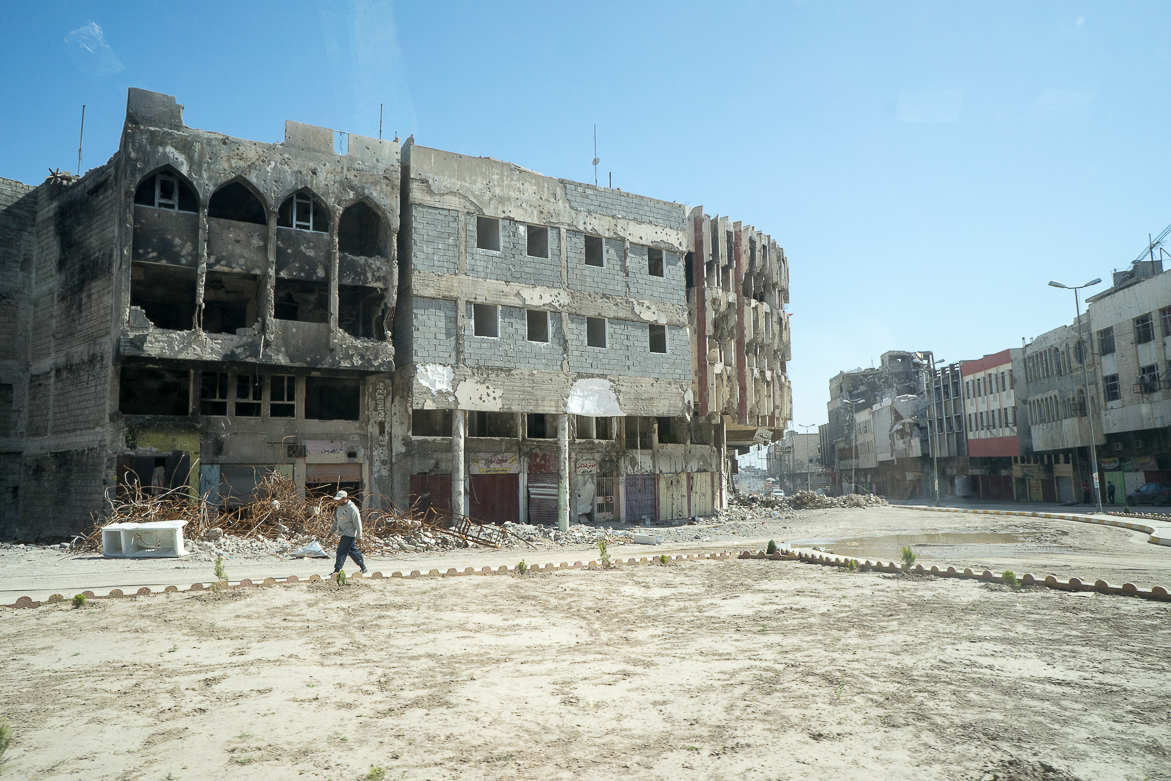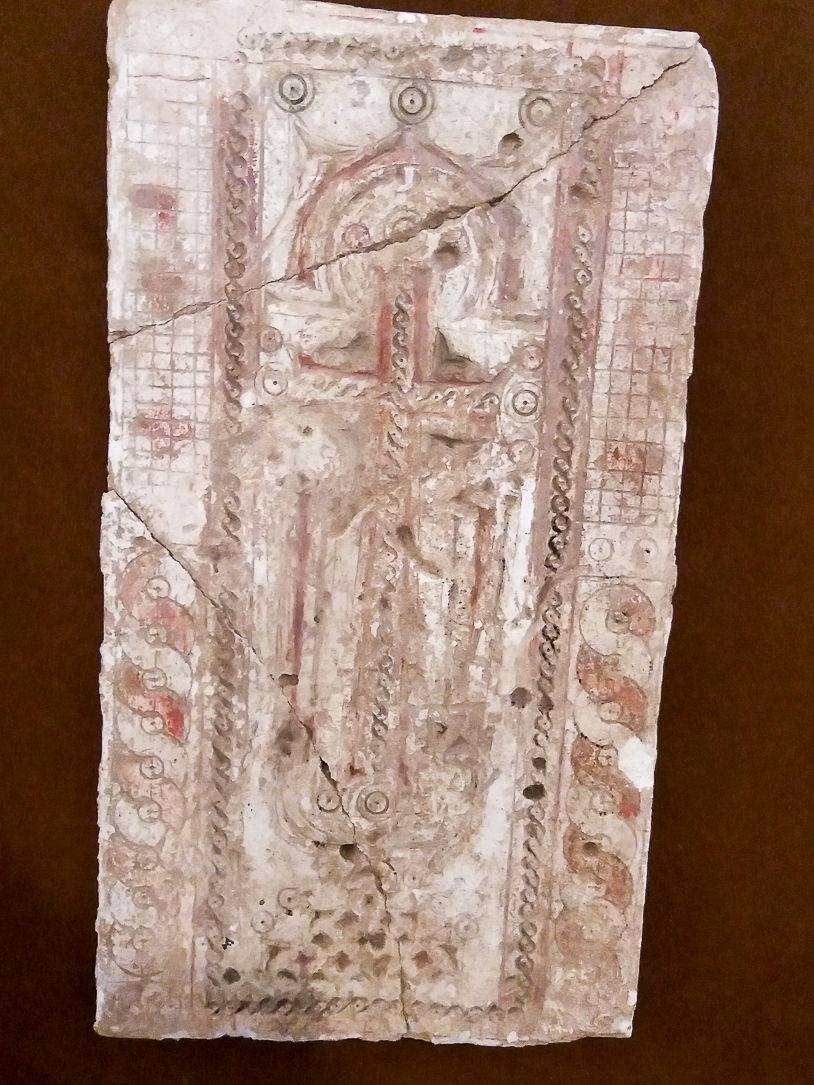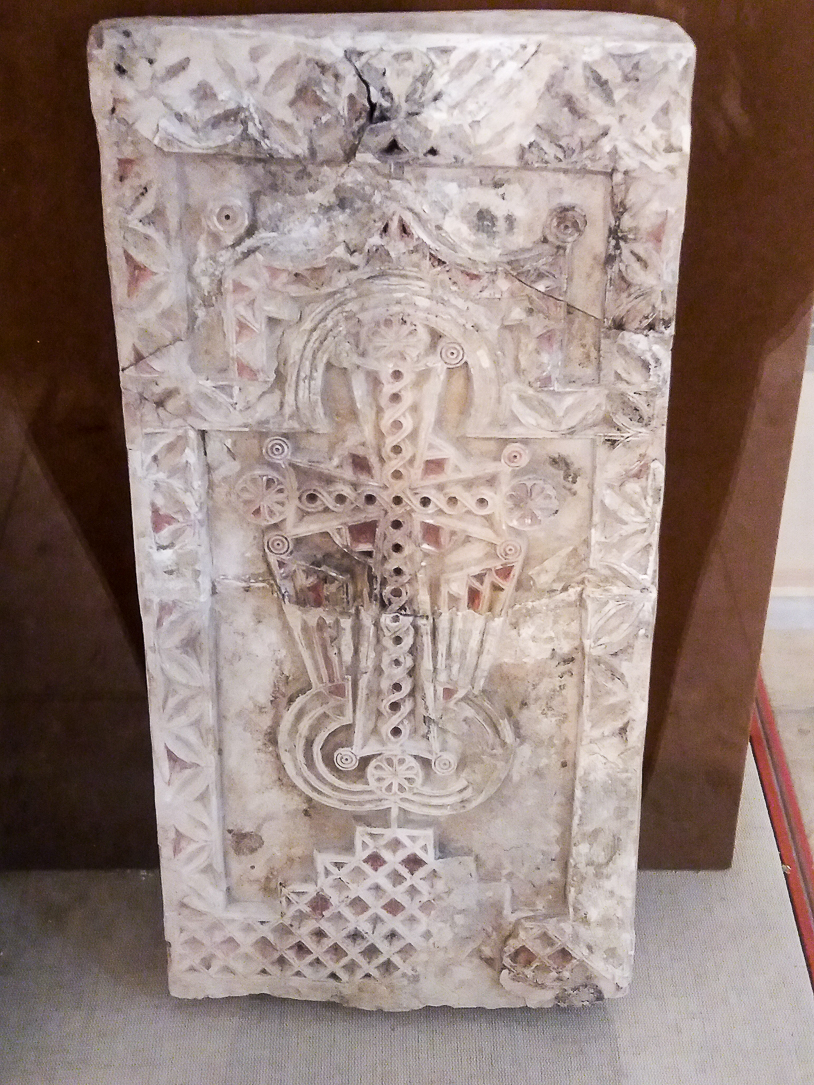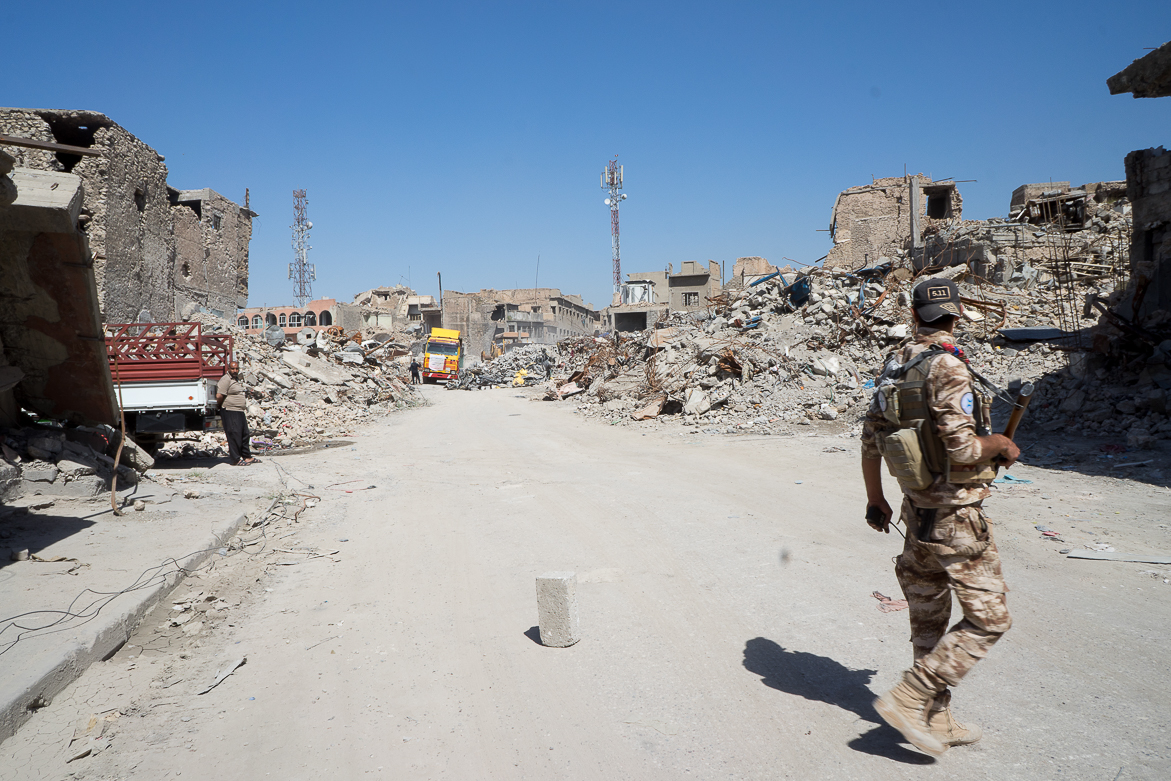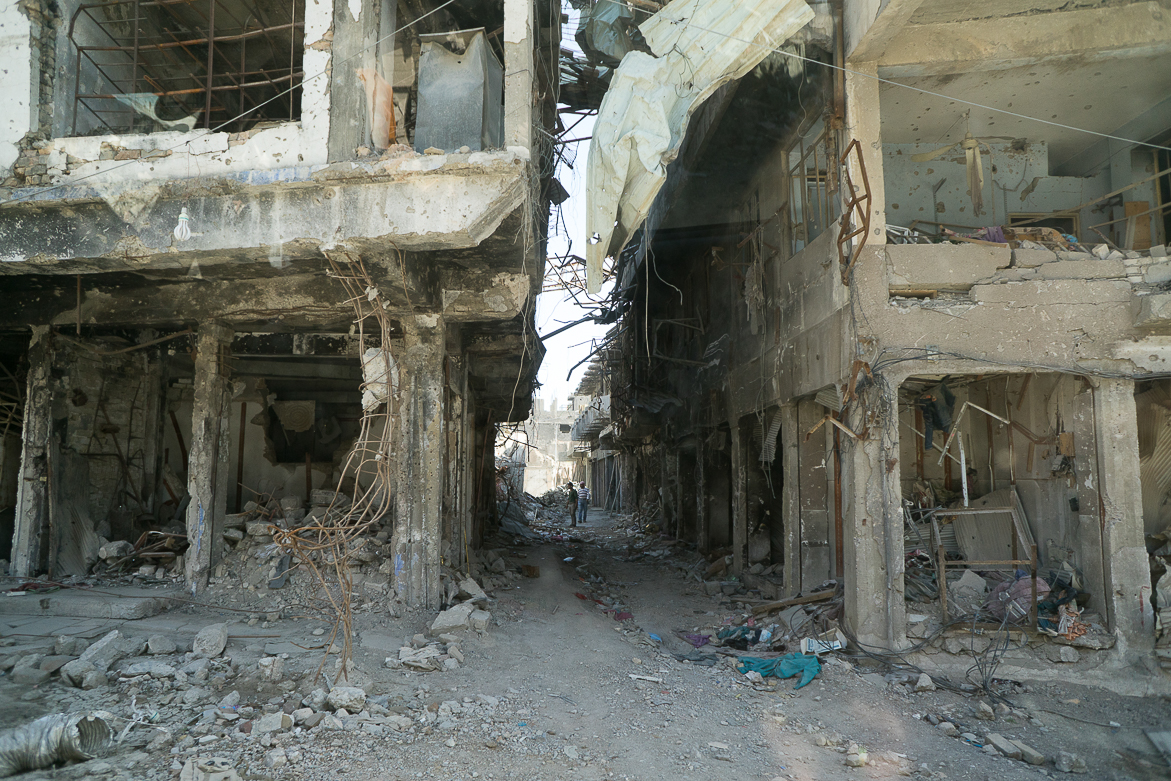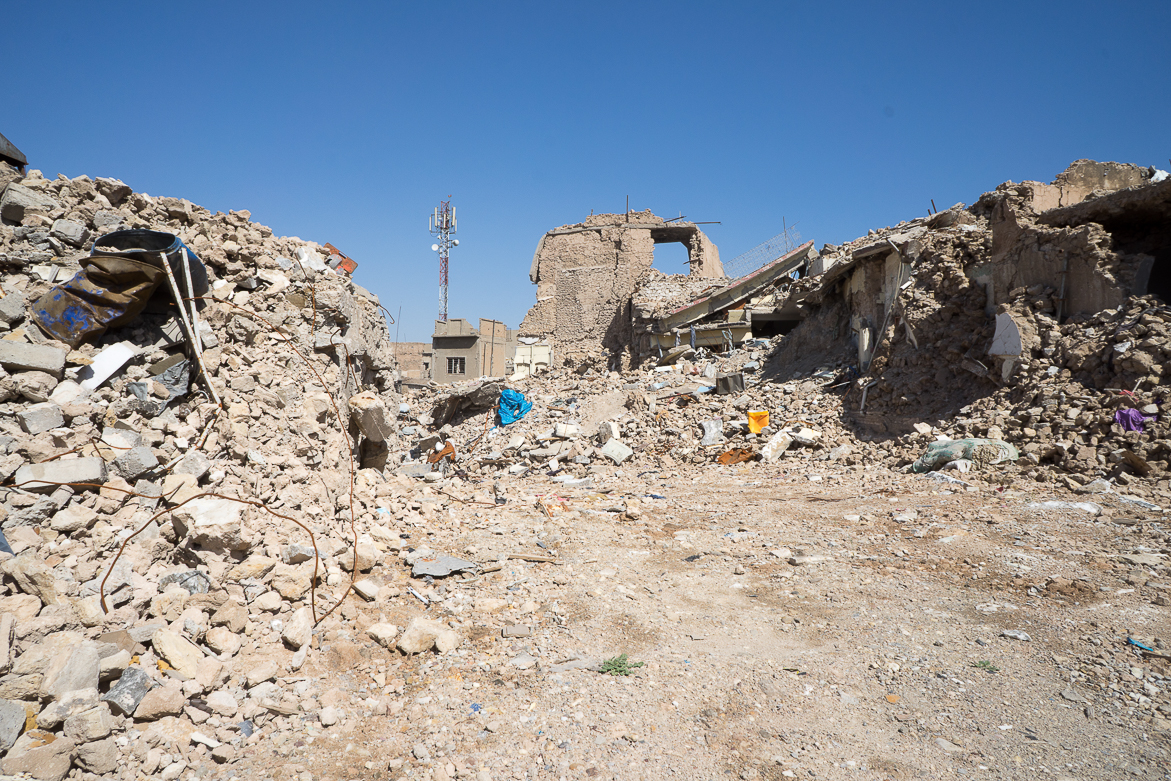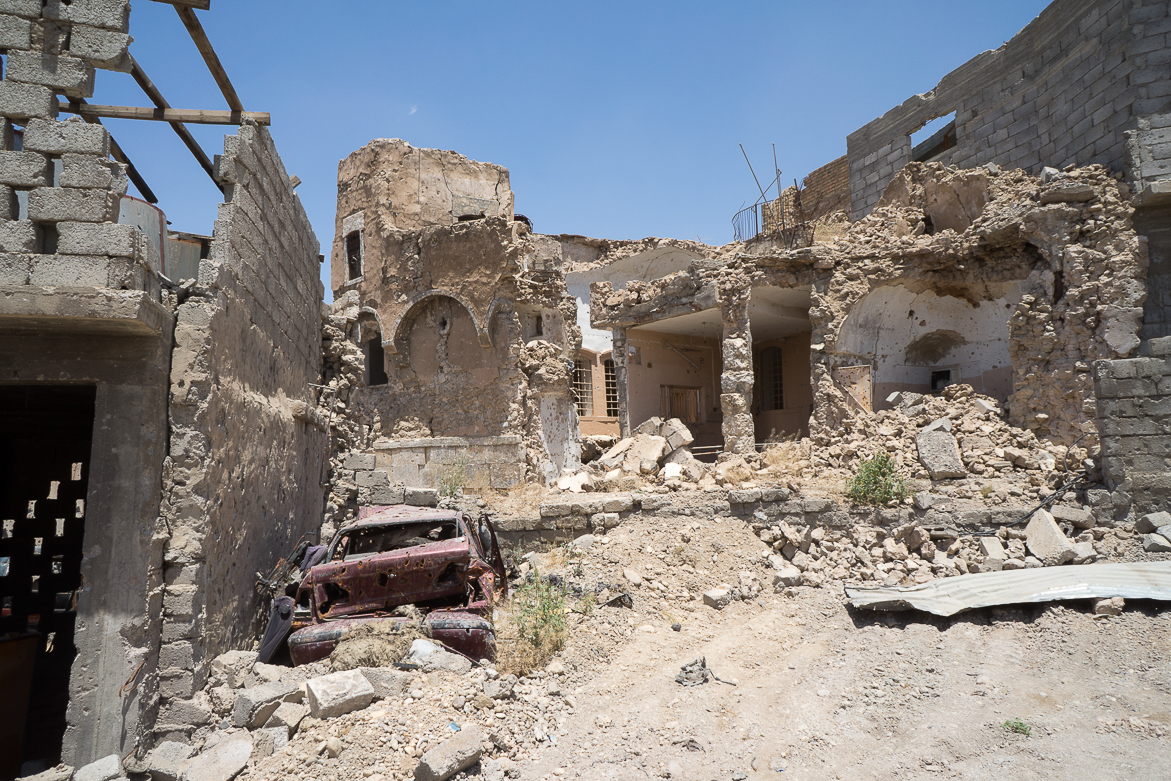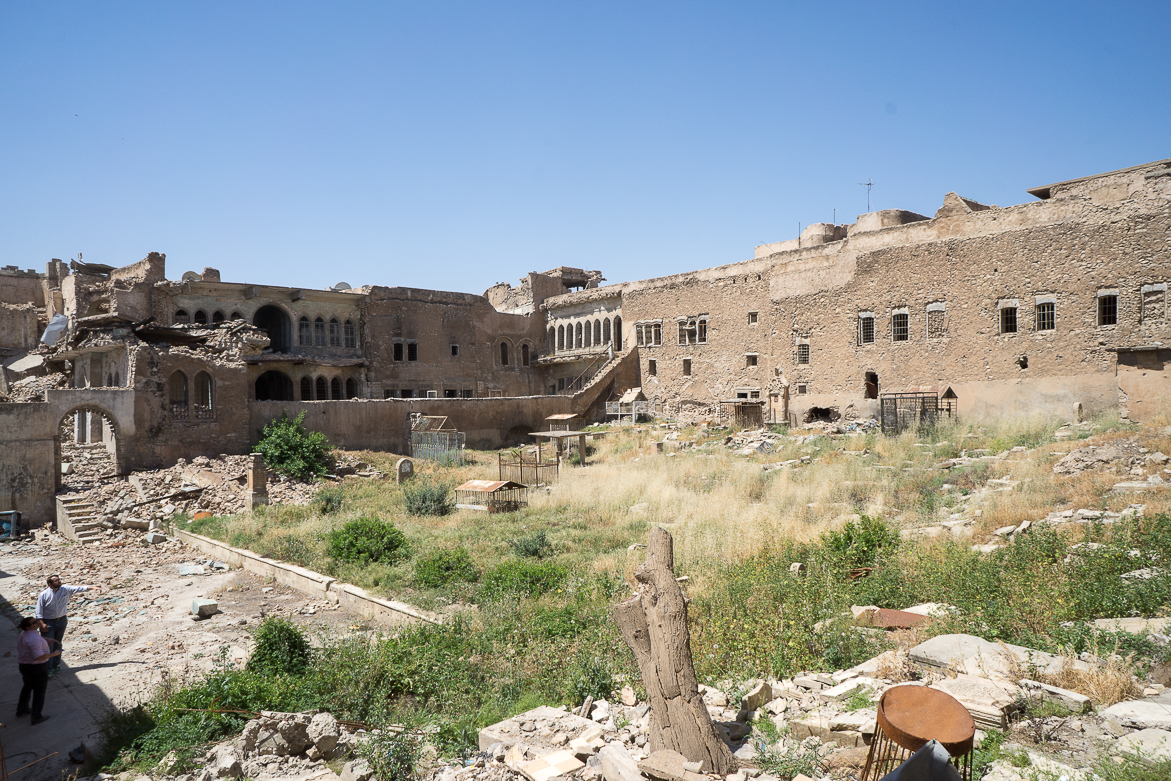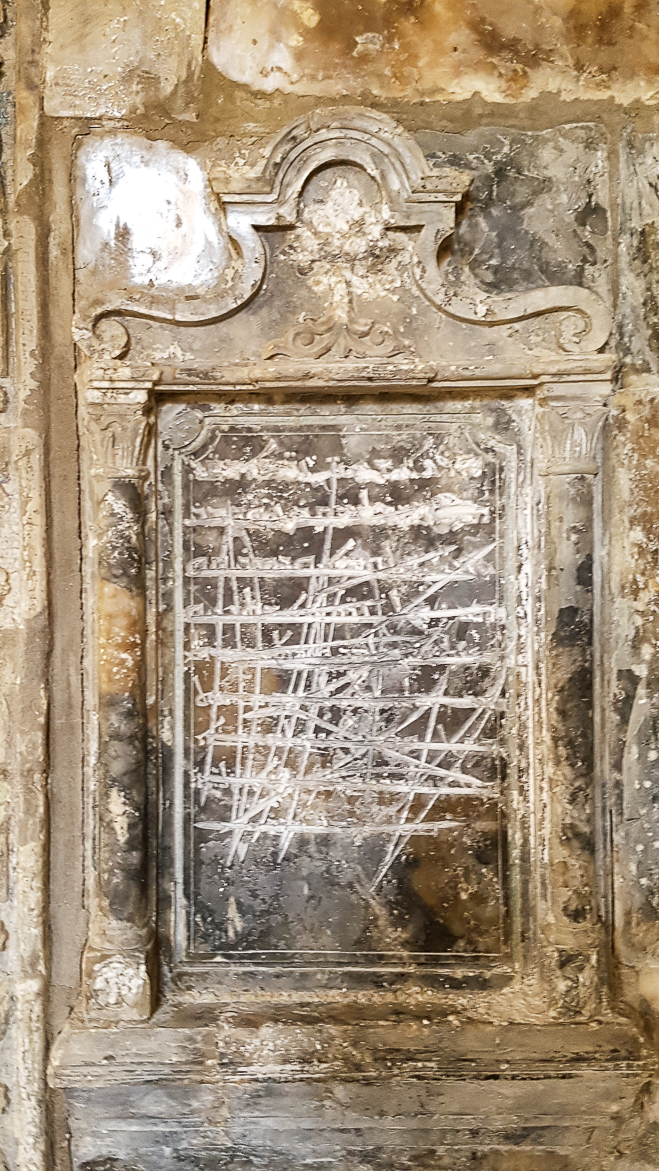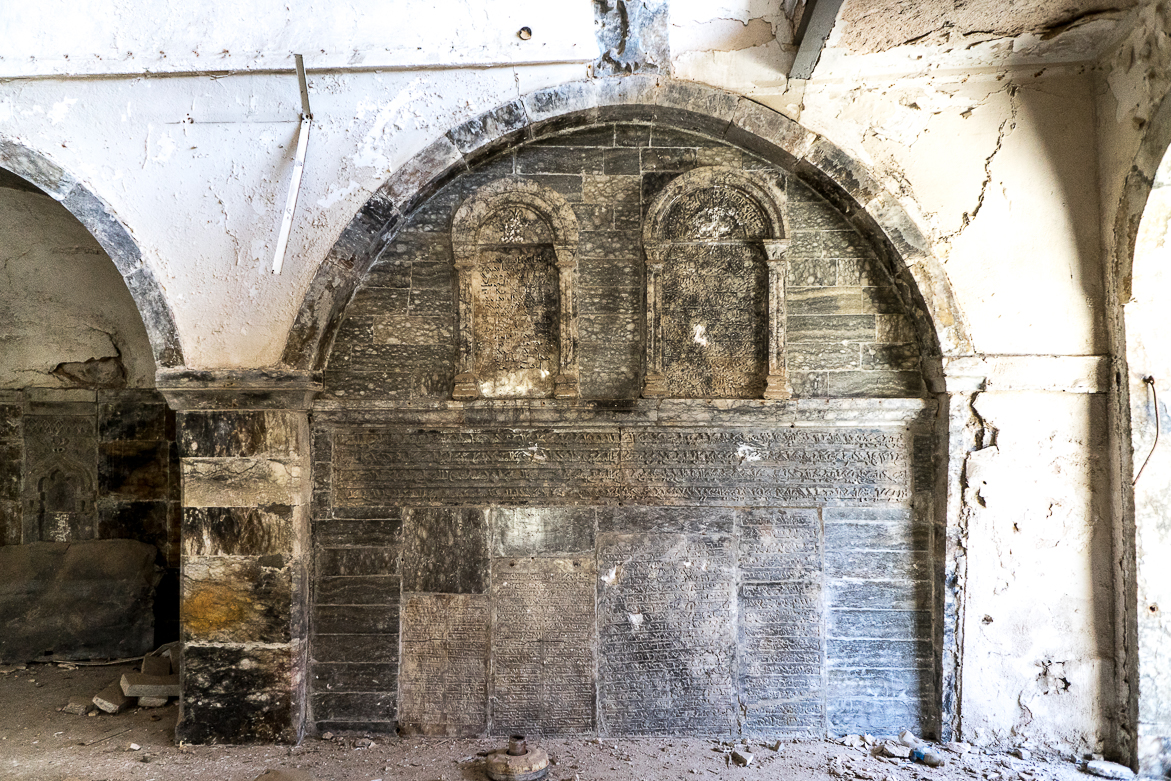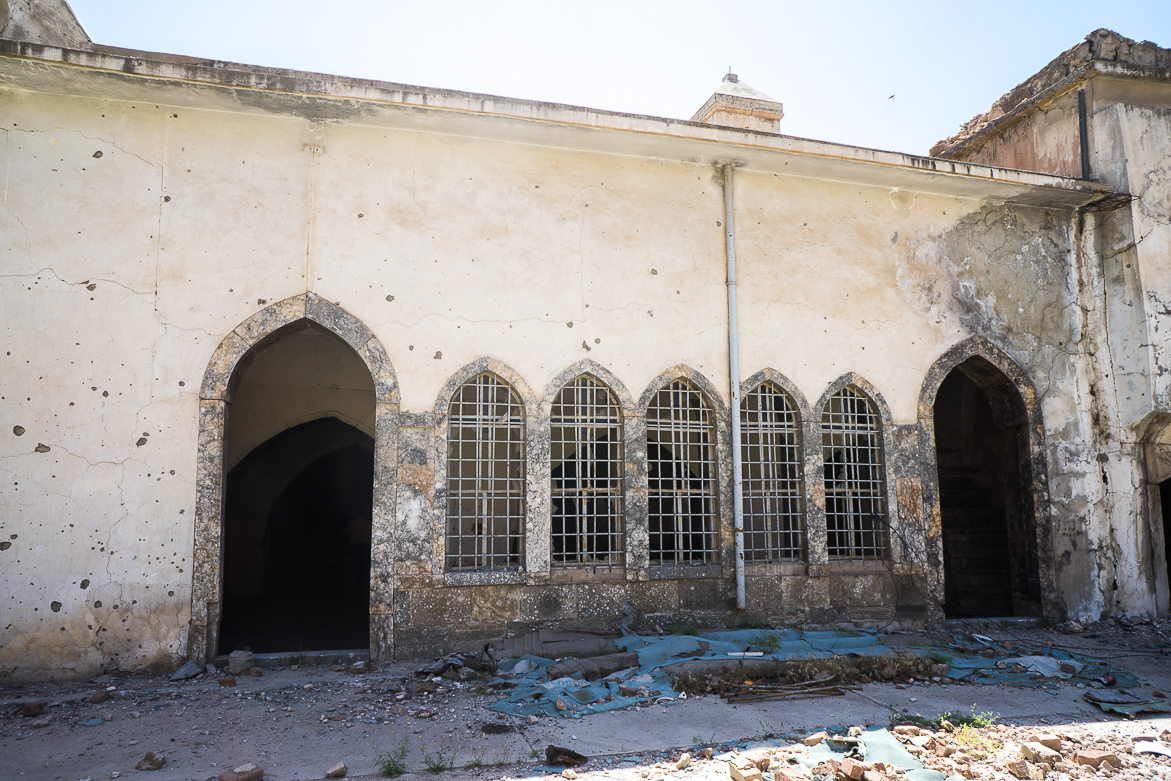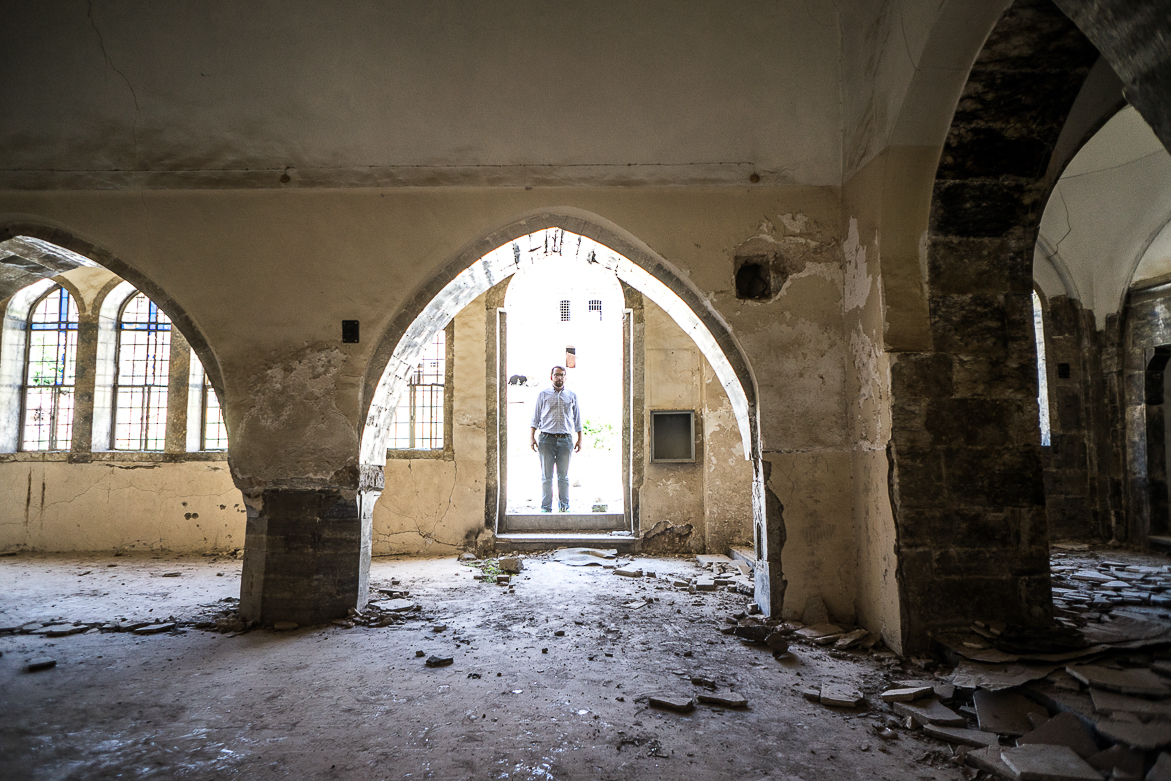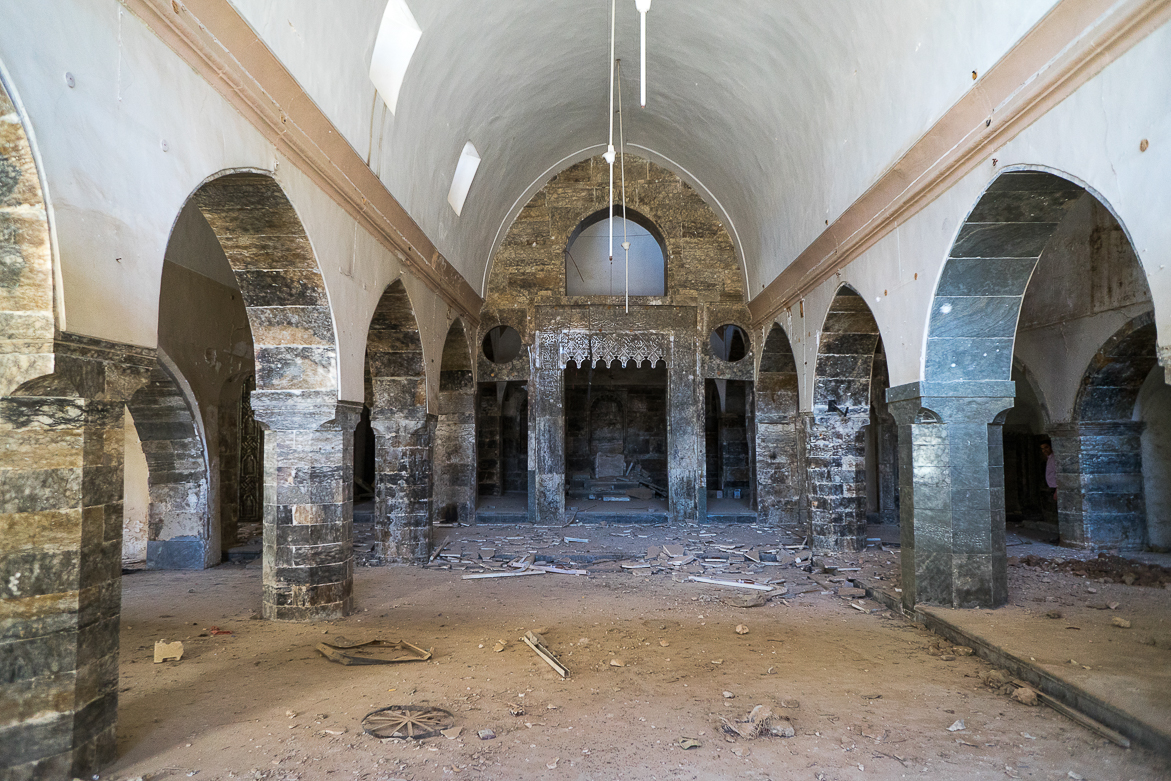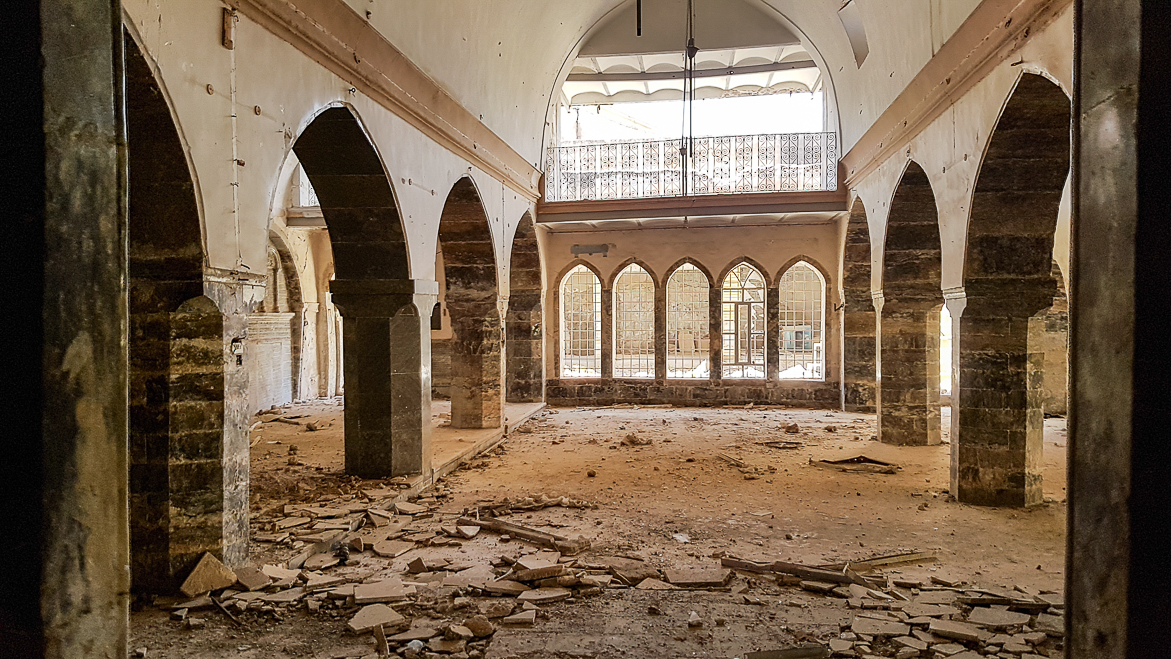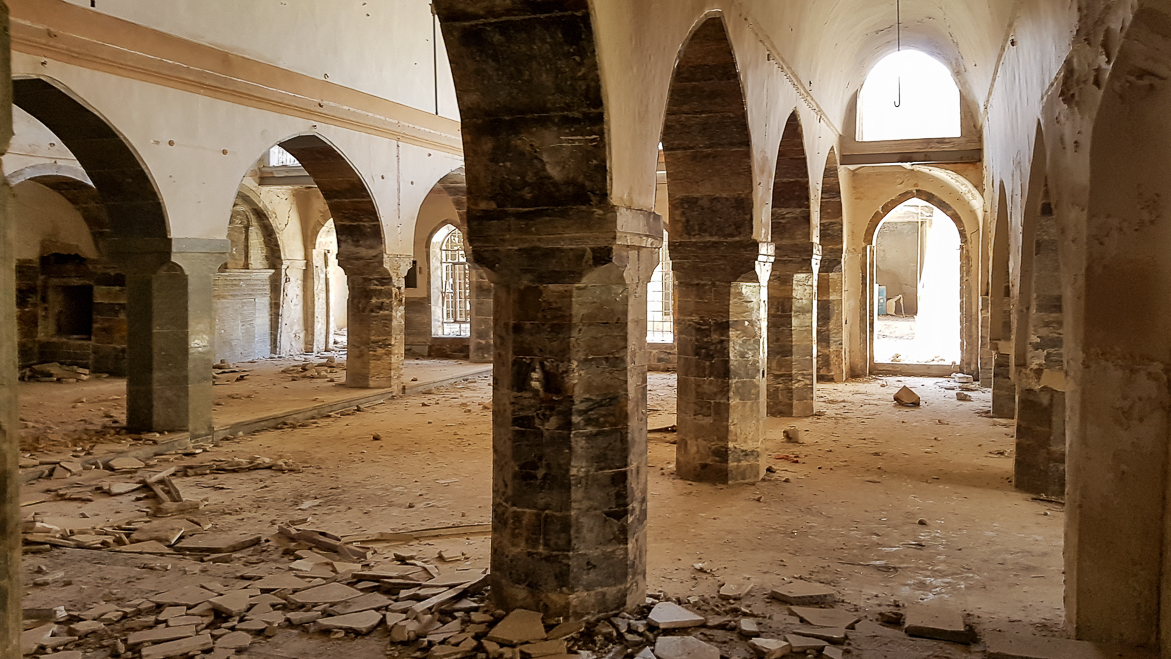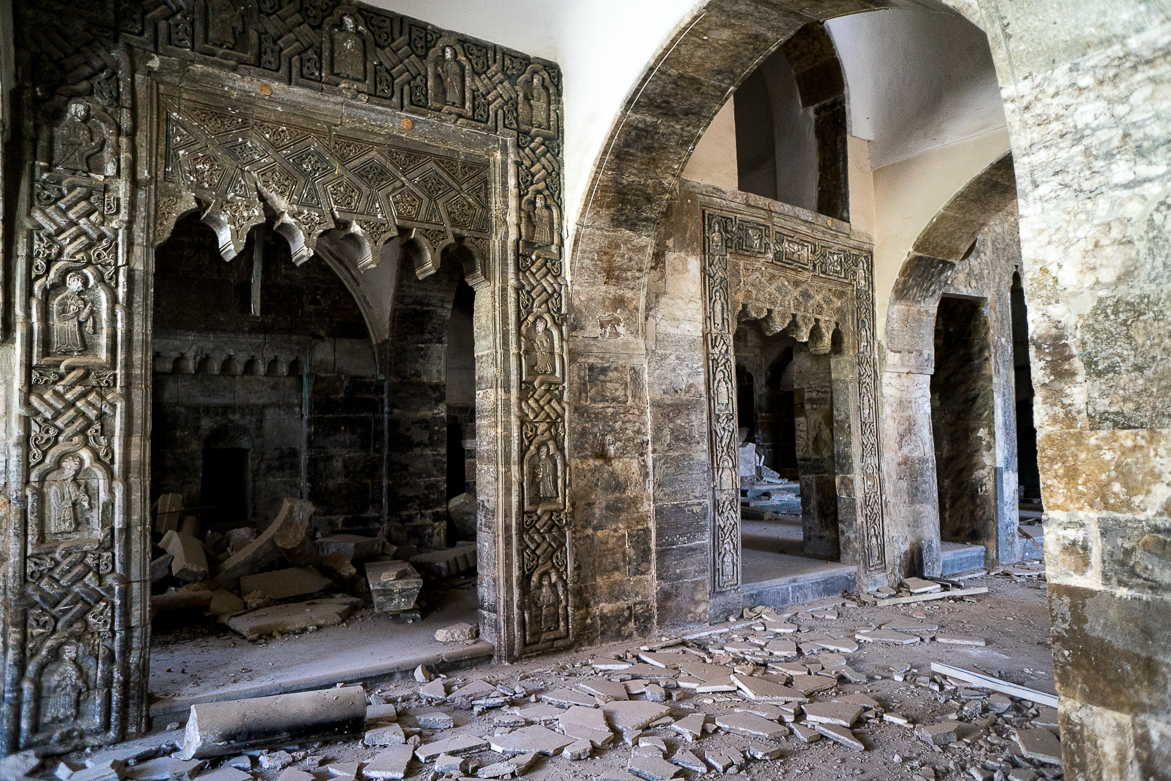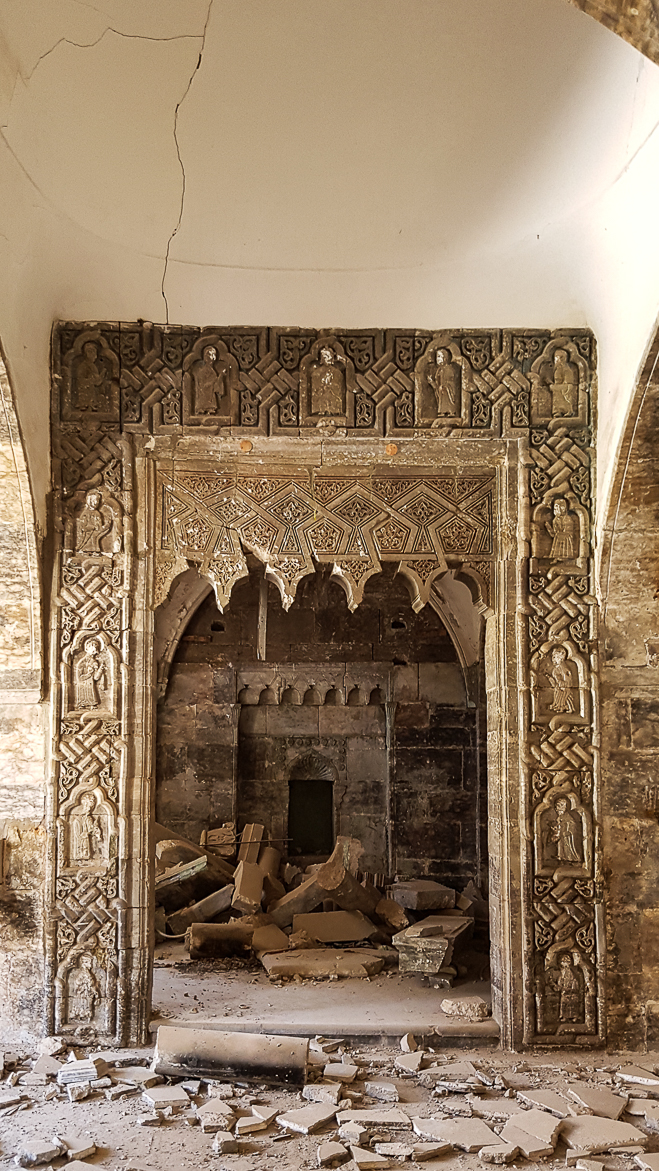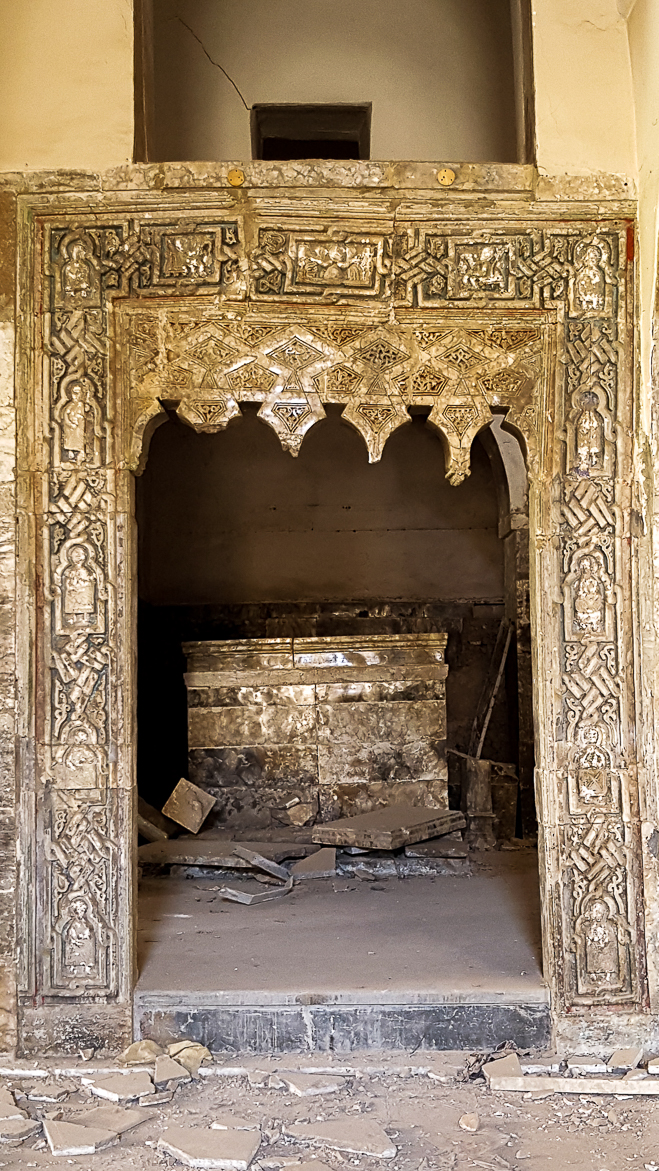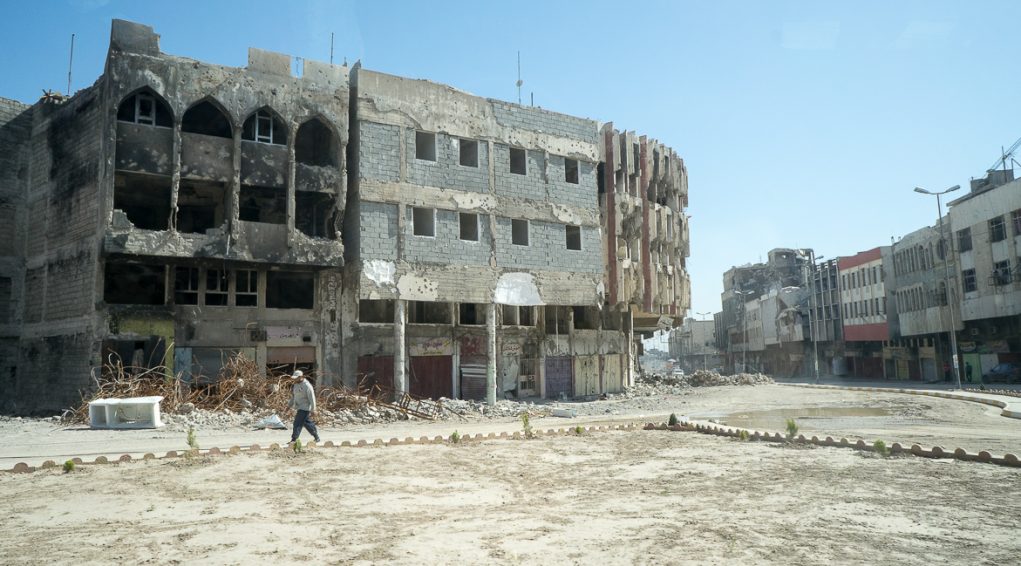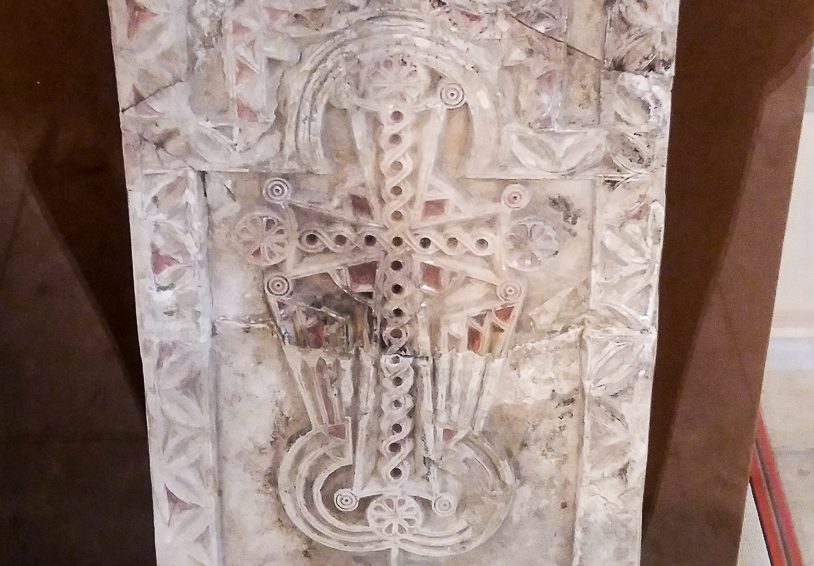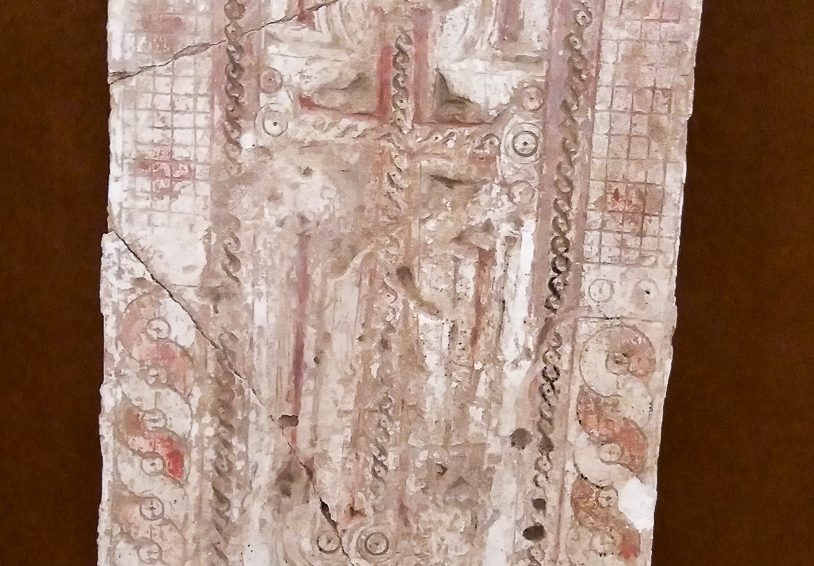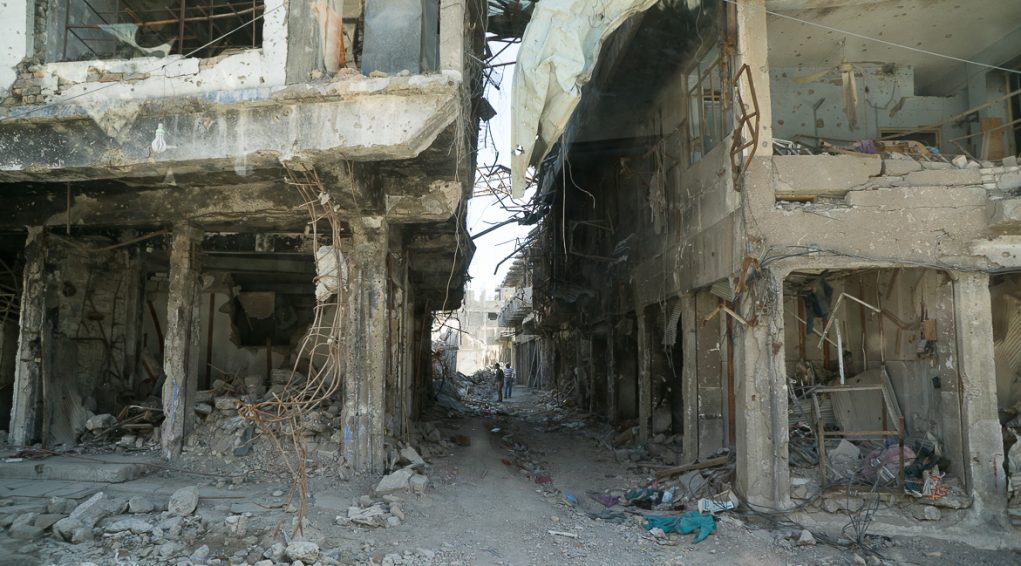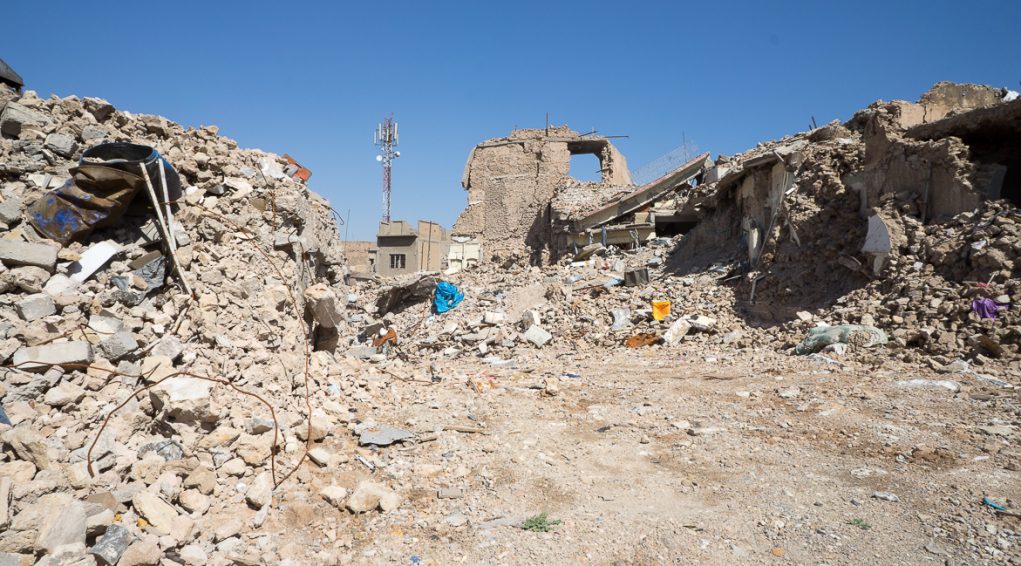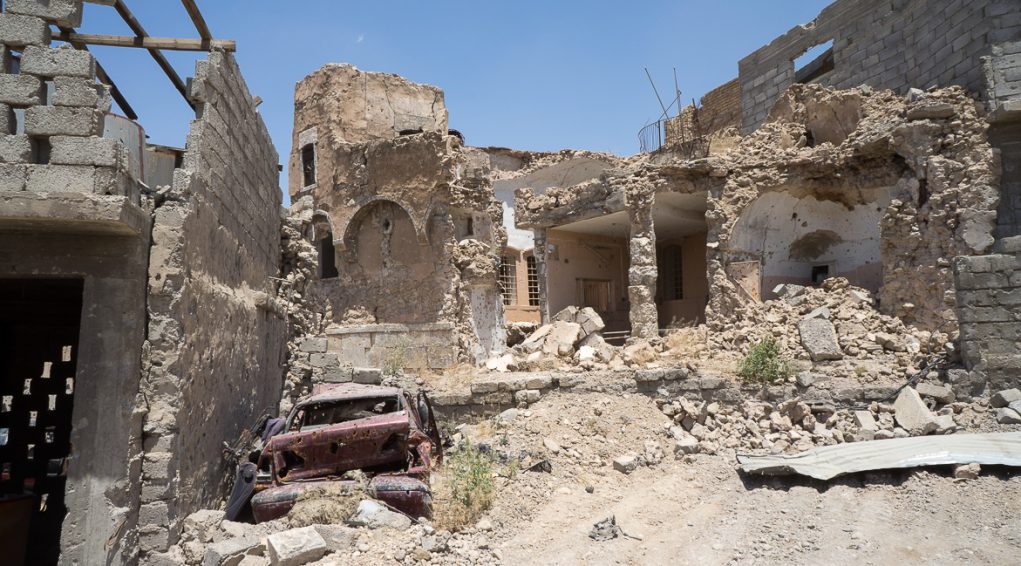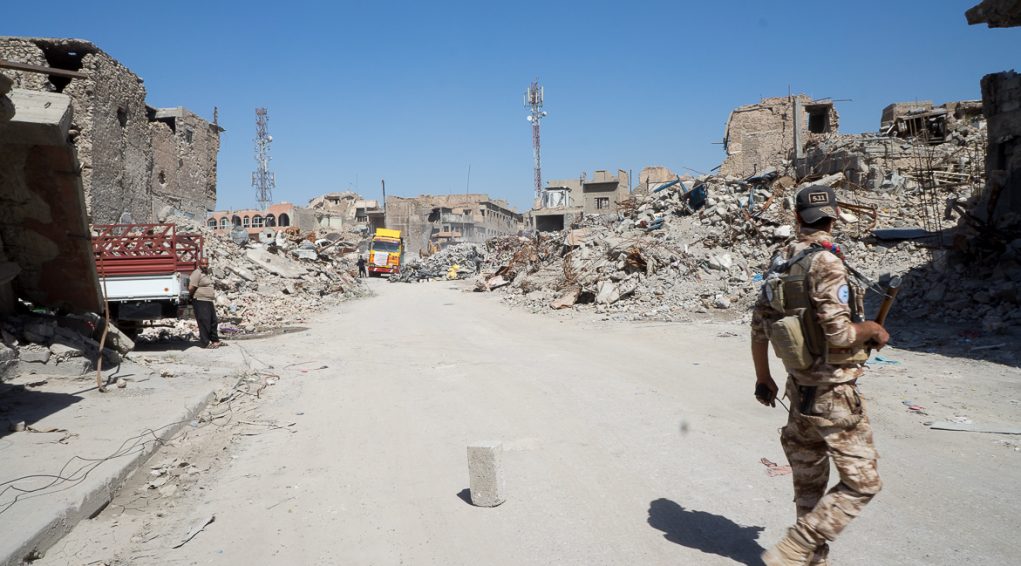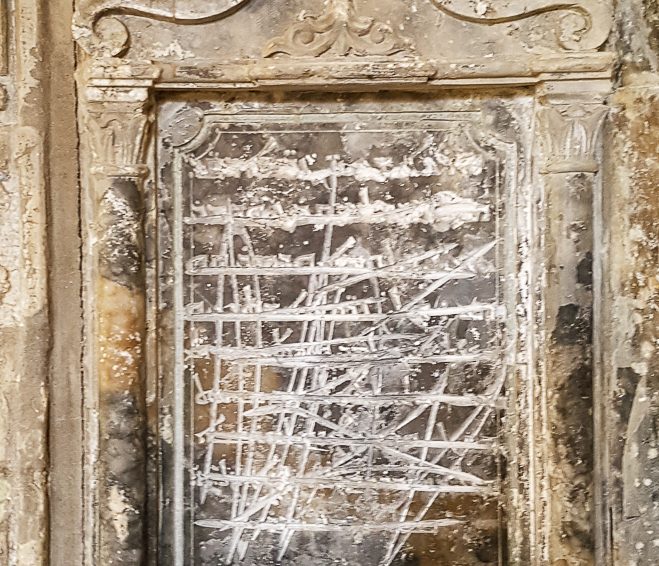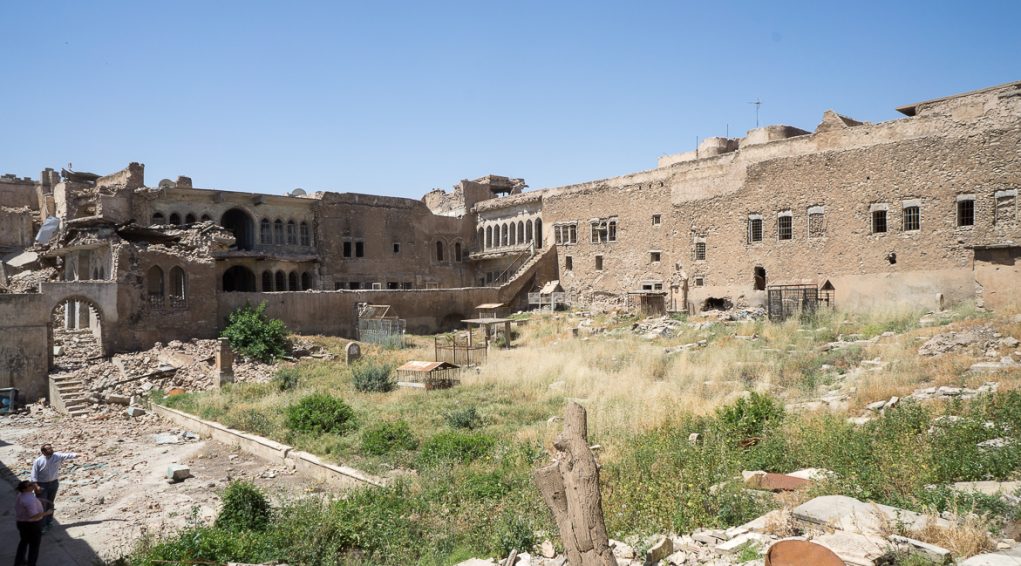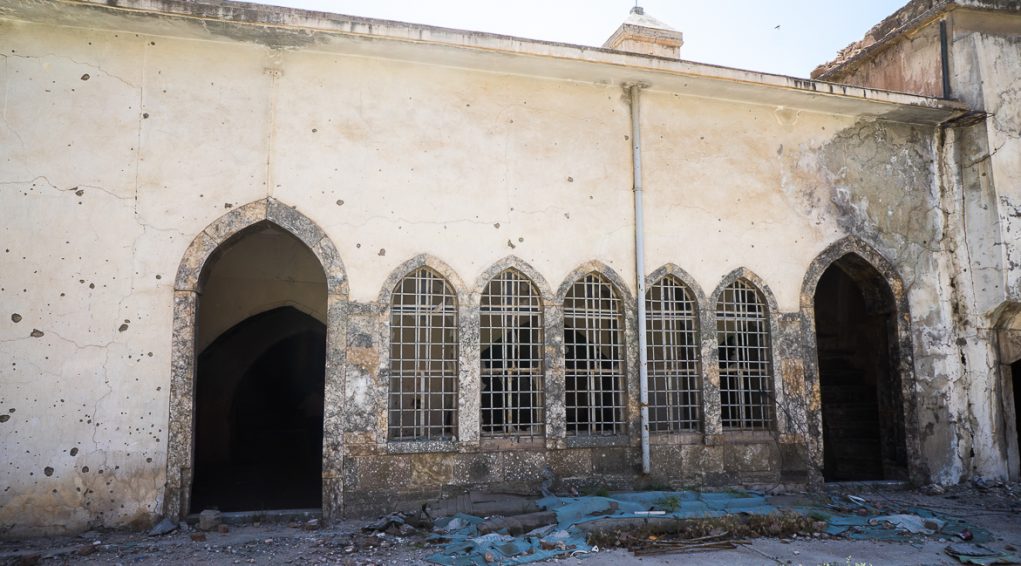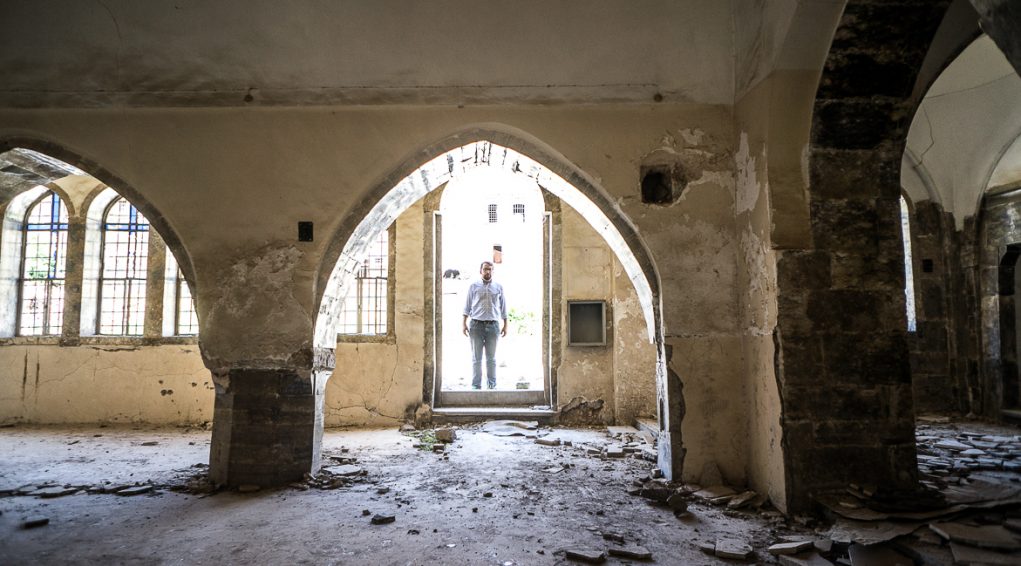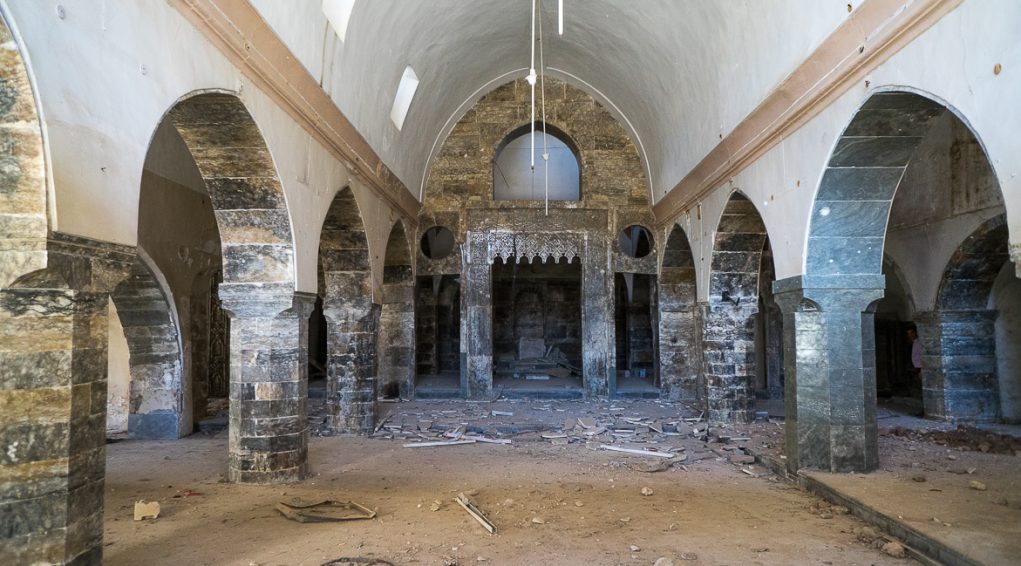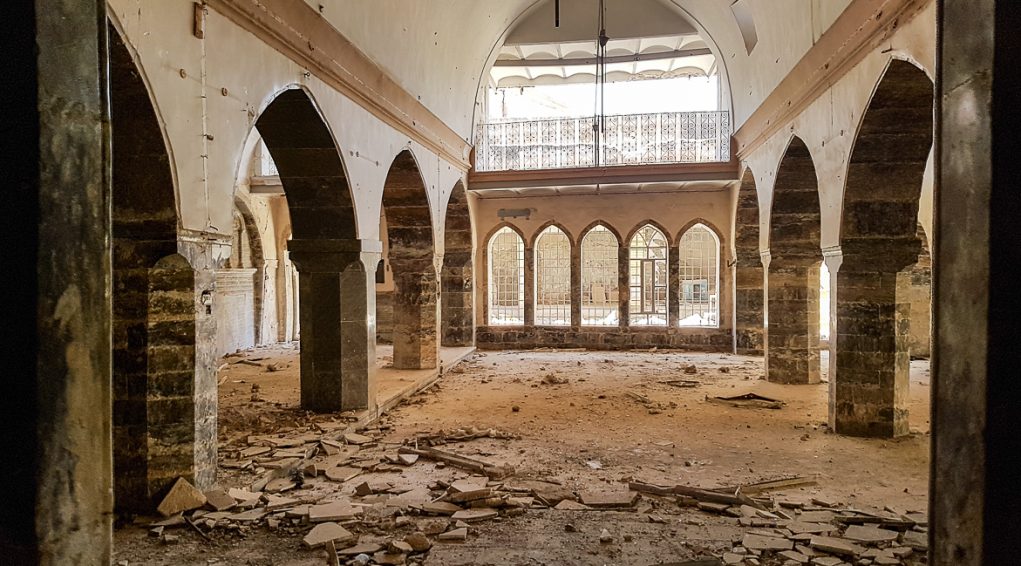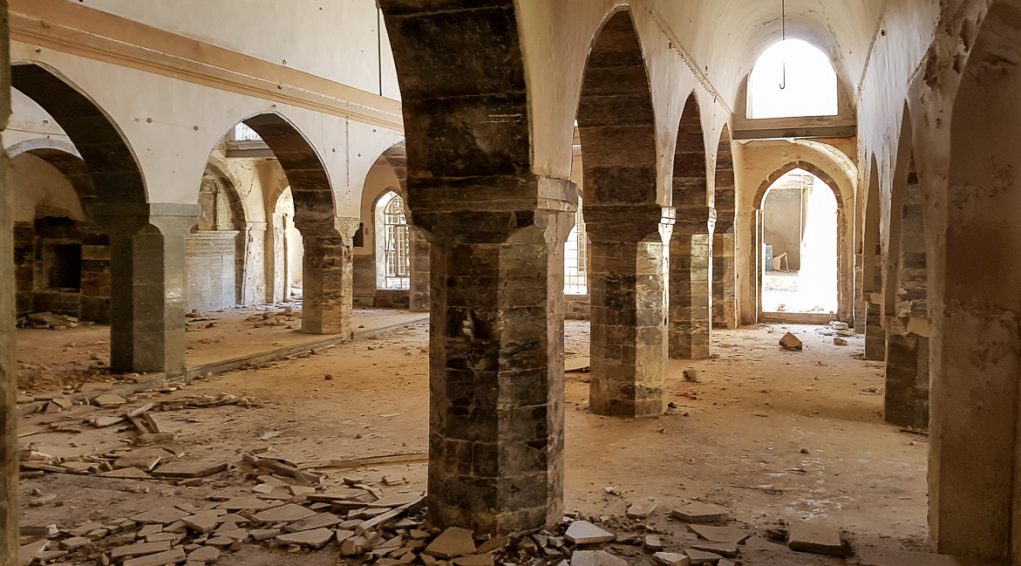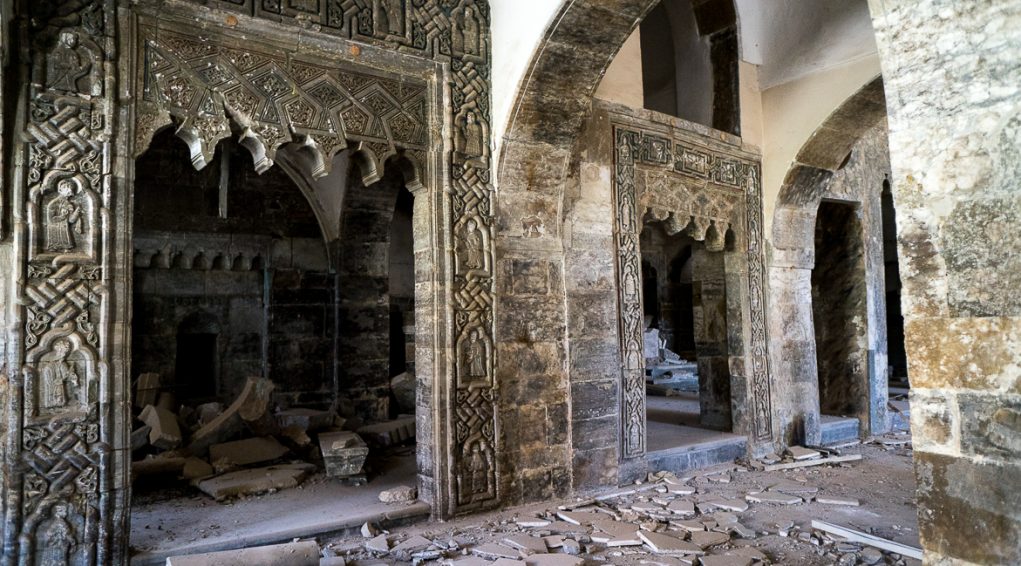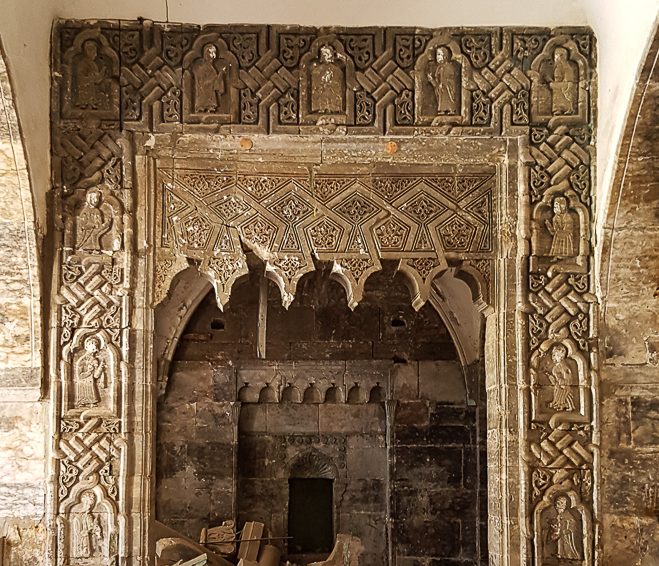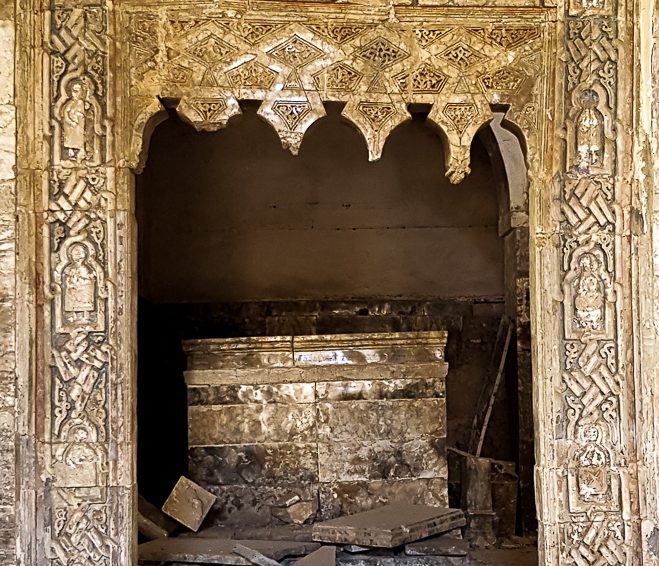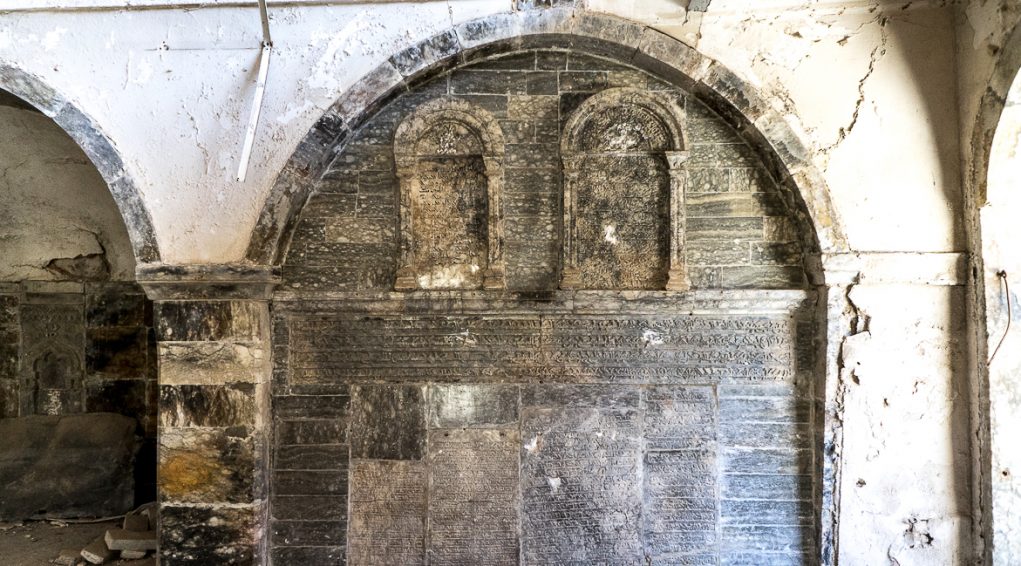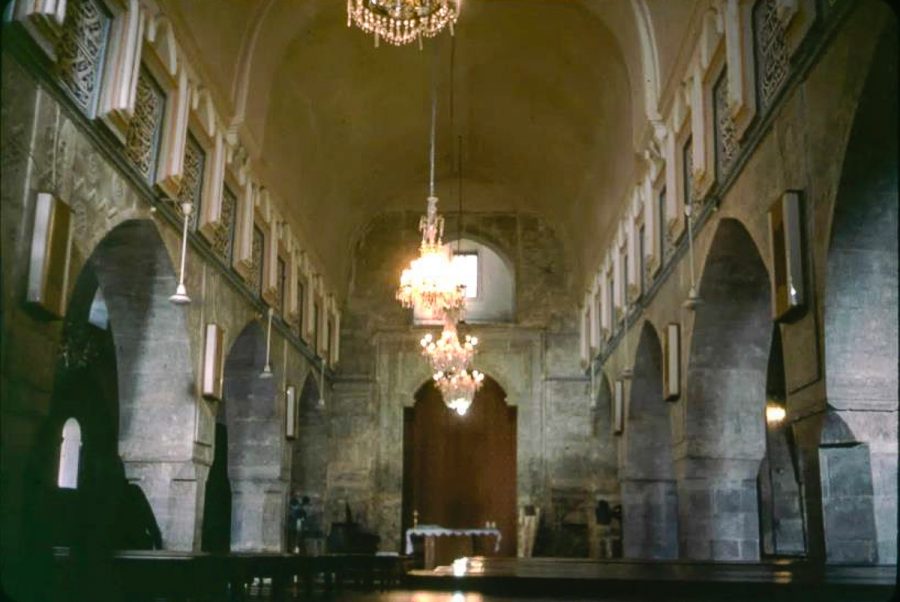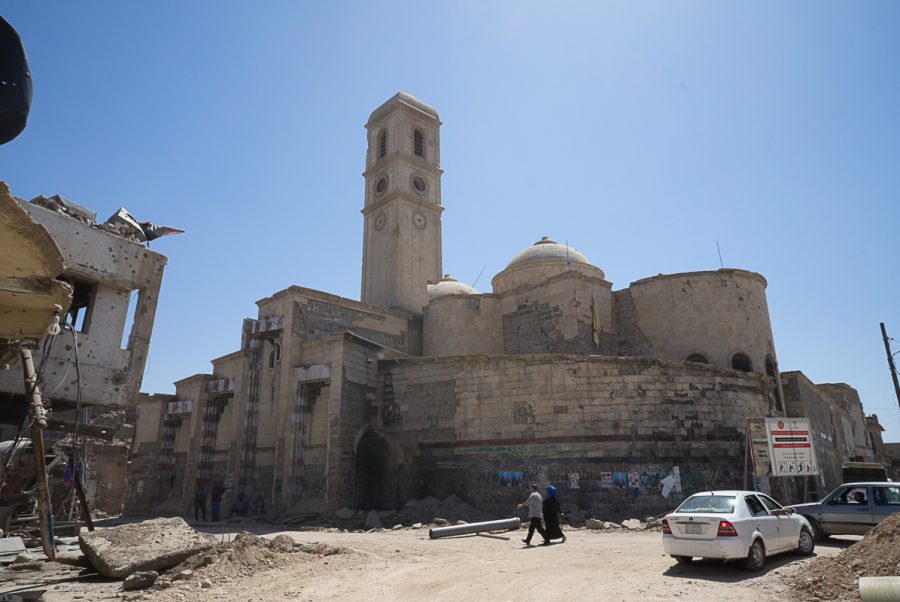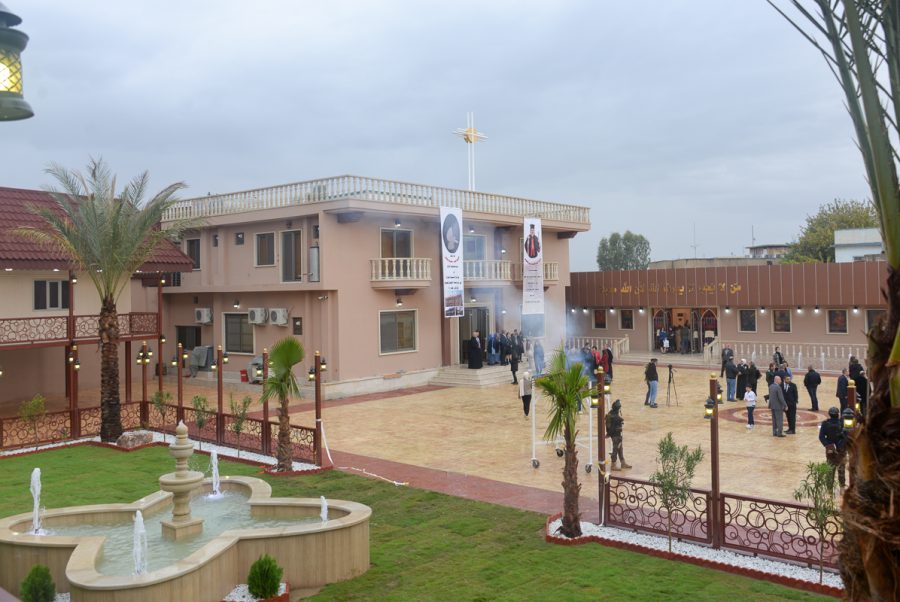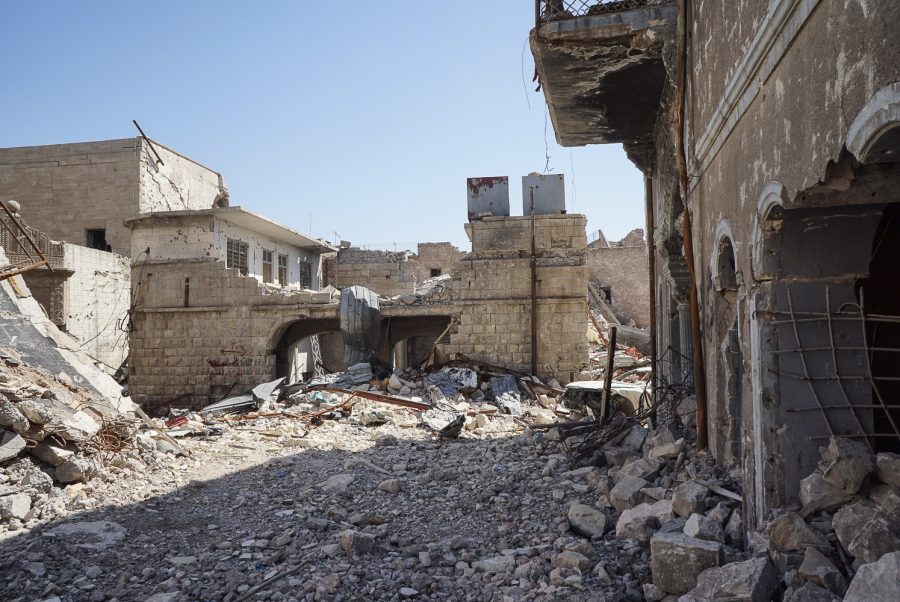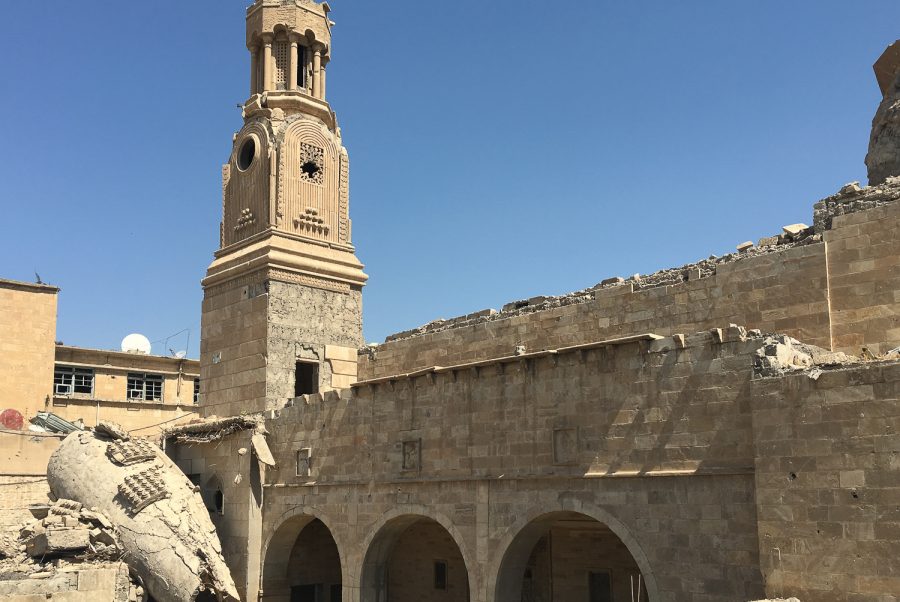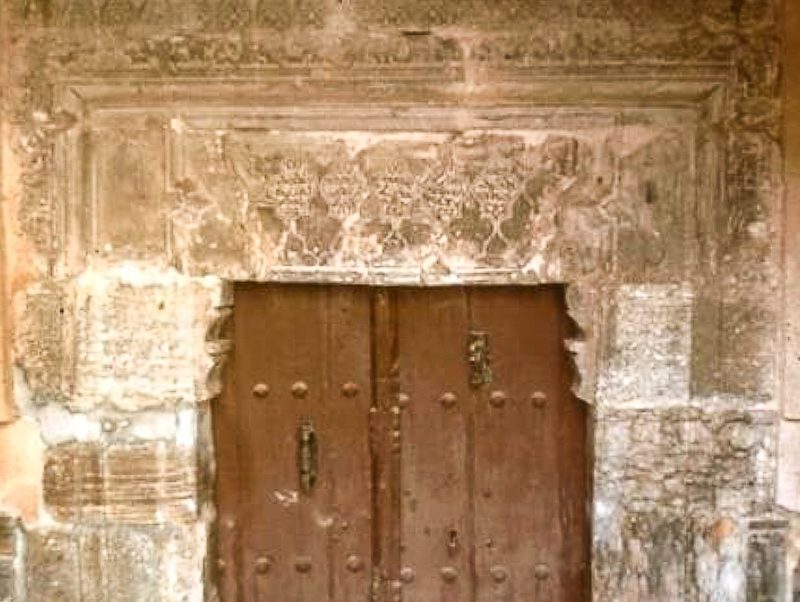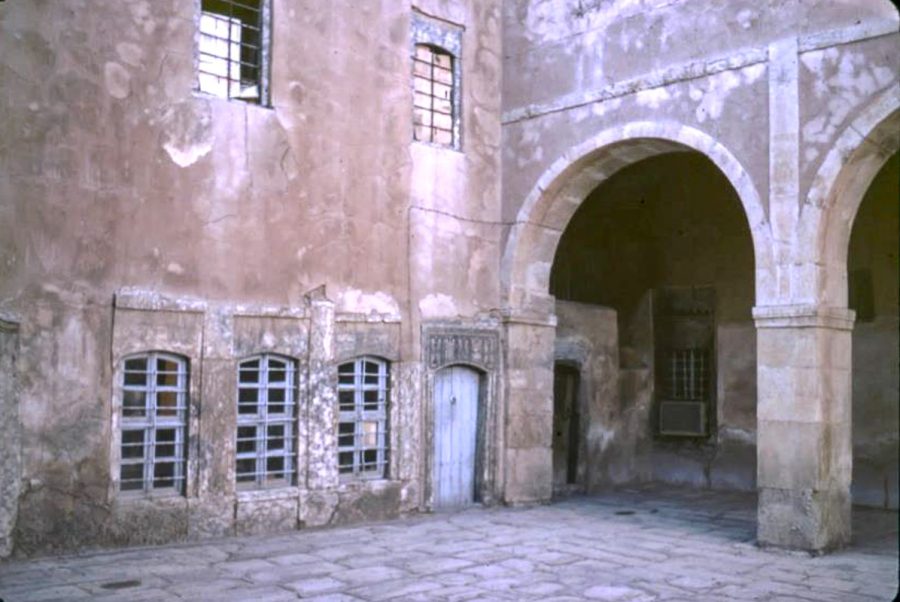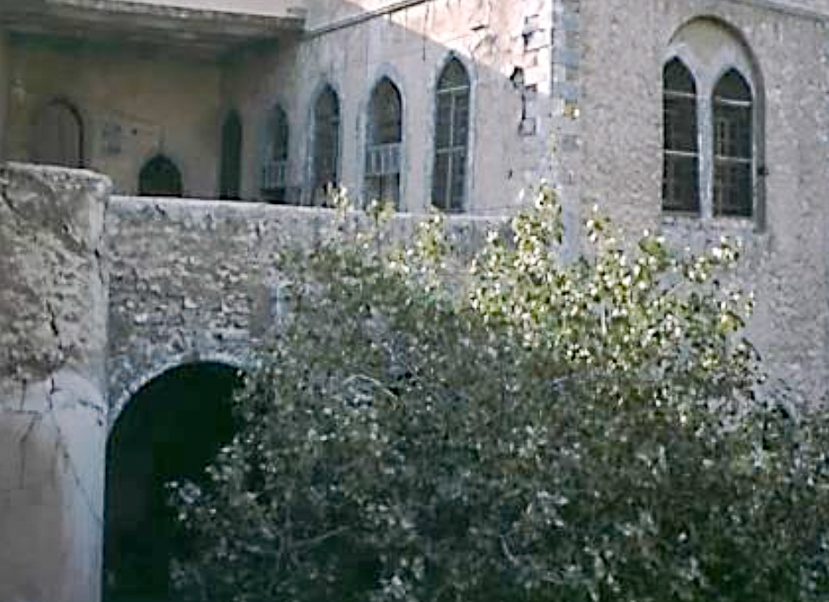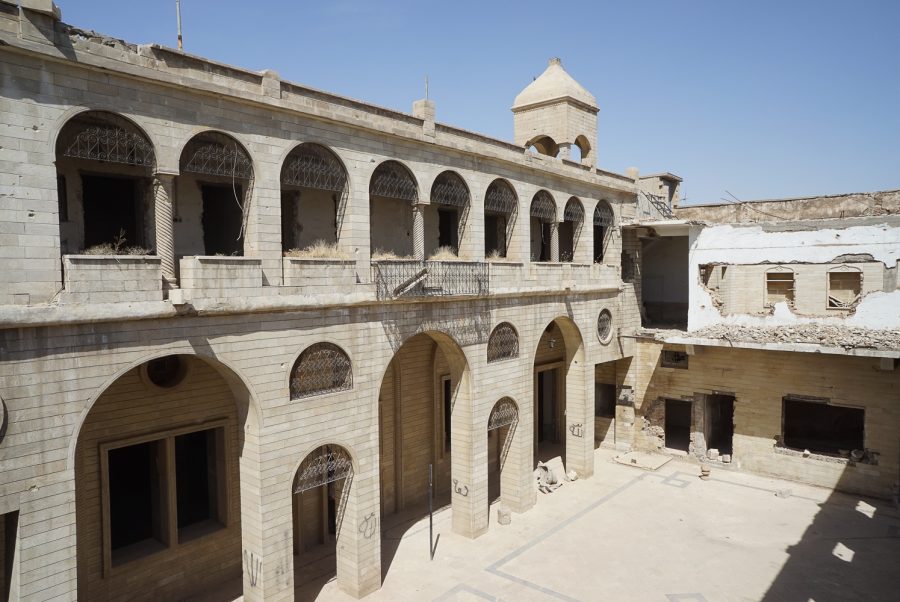The Mar Touma Syriac-Orthodox church in Mosul
The Mar Touma Syriac-Orthodox church is located at 36°20’27.0″N 43°07’31.5″E and 234 metres altitude, in the old city of Mosul, formerly delimited by the Ottoman city walls on the west bank of the Tigris river, opposite the ancient city of Nineveh.
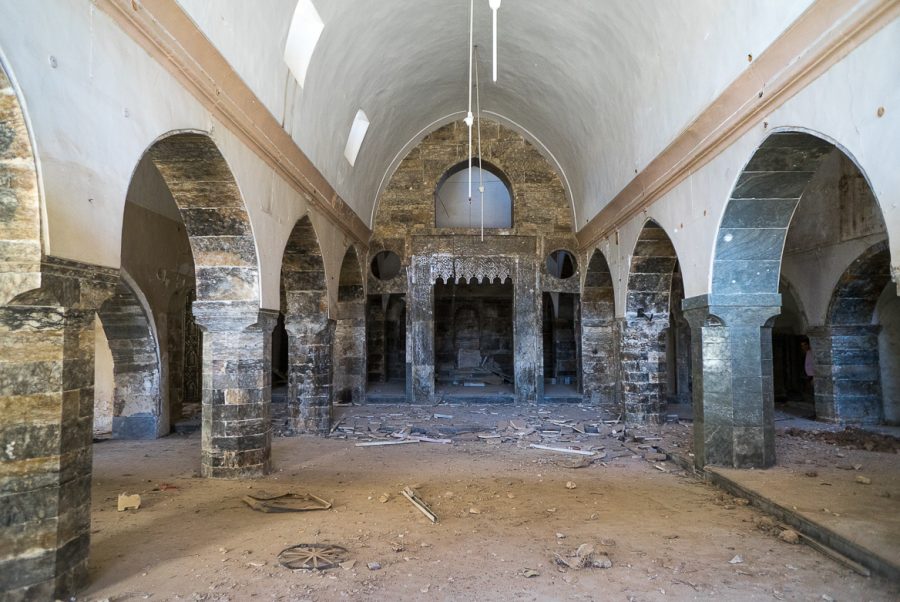
Legend has it that the Mar Touma Syriac-Orthodox church in Mosul was built on the site of the house where Saint Thomas was offered hospitality on his journey to India.The building, which is today found in the heart of the old city, was originally located outside of the walls of Mosul, built in 640. Its history is a complex one, as it was built in successive phases over the 7th, 18thand 14thcenturies.
More than a mere church, it is a complex five-nave architectural ensemble composed of two, or possibly even three, parallel churches, separated by arches with octagonal columns.
This tripartite architectural ensemble finds continuity and unity in form of the sanctuary which spans the north to the south with no separations. A total of eight royal doors separate the five-nave sanctuary.
| Pic : Mar Touma Syriac-Orthodox church in Mosul. Nave from 1848 and royal door from 1648. April 2018 © Pascal Maguesyan / MESOPOTAMIA |
Map of the Mar Touma Syriac-Orthodox church in Mosul © In “Les chrétiens de Mossoul et leurs églises pendant la période ottomane de 1516 à 1815”, Fr. Jean-Marie Mérigoux, o.p. Mossoul-Ninive, 1983, p.111 A.
Location
The Mar Touma Syriac-Orthodox church is located at 36°20’27.0″N 43°07’31.5″E and 234 metres altitude, in the old city of Mosul, formerly designated by the Ottoman city walls on the west bank of the Tigris river, opposite ancient Nineveh, 400 kilometres north of Baghdad. The church “straddles the al-gulaq and hazrag districts, today found close to the crossroads between the Faruq and Nineveh roads.”[1]
_______
[1] In « Les chrétiens de Mossoul et leurs églises pendant la période ottomane de 1516 à 1815», Fr. Jean-Marie Mérigoux, o.p. Mossoul-Ninive,1983, p.104
At the origin of the Syriac-Orthodox church
Syriac tradition attributes the evangelization of Mesopotamia to the apostle Thomas and his disciples Addai and Mari, however,“it seems that the introduction of Christianity in fact only dates back to the beginning of the 2nd century and that it was conducted under the influence of Judaeo-Christian missionaries from Palestine[1]. This Mesopotamian Christianity started organizing itself in Seleucia-Ctesiphon, on the banks of the Tigris River, 30 kilometres south of Baghdad, where tradition tells us that Saint Thomas made a halt on his way towards India. And it is right here, on a hill of the Koghe district, that the first patriarchal church of the Church of Mesopotamia was built and its Catholicate established. This Syriac-language-based primitive Christianity still forms the shared foundation of the local Iraqi churches and their communities, which perpetuate and pass on this Christian heritage.
This common foundation progressively broke up into a multitude of different churches over the period stretching from the Council of Nicaea in the 4th century up into the 20th century, often due to geopolitical, rather than religious, considerations.
Indeed, the first ecumenical Council of Nicaea in 325, convened by the Roman Emperor Constantine I, was held without the Persian bishops, except for Jacob of Nisibis, as “it was out of the question to the other bishops, in times of never-ending or nearly never-ending war, to go and sit in an assembly held in an enemy country, convened – and what’s more presided over – by the Roman Emperor[2]”. It must be said that from the time of Constantine’s conversion to Christianity on, the Sassanid Emperor Shapur II’s attitude to Persian Christians turned from tolerance to mistrust. This mistrust eventually turned into hostility, churches were destroyed and the clergy persecuted. “The aim of the persecution was not to annihilate the Christians but to lead them to apostasy, once the hierarchy of the church had been wiped out.[3]”
A century later, in 431, the Council of Ephesus sentenced the Patriarch of Constantinople Nestorius, who professed the two distinct natures of Christ (hypostasis): one divine, as the son of God, and one human, as the son of Mary. This Christological thesis was considered heretical and Nestorius was removed from office. Spurred on by geopolitical rivalries between the Roman Empire and the Persian Sassanian Empire, the Church of the East turned to Nestorianism from the second half of the 5th century onwards, and spread throughout Mesopotamia, Persia and up into India.
Twenty years later, in 451, the Council of Chalcedon was the staging for a new Christological controversy. The Syriac, Egyptian, Ethiopian and Armenian Churches were blamed for professing monophysite theory i.e. that within the person of Jesus Christ, his human nature was absorbed into his divine nature, and that Christ has only one divine nature. This controversial doctrine led to a further split and the churches concerned became autocephalous, with a view to preserving their own geopolitical interests.
In the 6th century, Saint Jacob Baradaeus, a Syriac monk, reorganised the Syriac church. After his episcopal ordination, he embarked on a lengthy journey visiting all the Syriac regions to ordain large numbers of bishops, priests and deacons. It is in his honour that the Syriac church is characterised as “Jacobite”. He was in fact the founder of the Syriac -orthodox church, which had no ties with western Christianity for centuries, developed in often complex situations, and has survived to the present day despite a series of critical events (the development of Islam, the Arab conquest, the Abassid caliphate from the 8th to the 12th centuries, the Mongol invasions, the fall of Constantinople in the 15th century, the Turkish-Ottoman domination, the Young Turks genocide of the Armenians in 1915- 1918, and Islamic persecution for criminal gains at the start of the 21st century).
_______
[1]In “Vie et mort des chrétiens d’Orient. Des origines à nos jours”, Jean-Pierre Valogne, Fayard, March 1994, p.737
[2]In Histoire de l’Église de l’Orient, Raymond le Coz, published by Éditions du Cerf, 1995, p.31.
[3]In Histoire de l’Église de l’Orient, Raymond le Coz, published by Éditions du Cerf, 1995, p.33.
Fragments of the Christian history of Mosul
This chapter is largely based on the work of Brother Jean-Marie Mérigoux o.p. who lived in Iraq for 14 years from 1968 to 1983 as part of the Dominican mission for Mesopotamia, Kurdistan and Armenia, based in Mosul. See, two books by Brother Jean-Marie Mérigoux, in particular: « Va à Ninive ! Un dialogue avec l’Irak », Éditions du Cerf, October 2000; and « Entretien sur l’Orient chrétien »,Éditions La Thune, Marseille, July 2015.
Mosul “remains a Christian metropolis,”[1]as attested by its history, and its ancient and modern heritage, which persists despite recent catastrophic events.
Although the first archdiocese is attested to in 554,[2]it is also important to take into account the Paleo-Christian apostolic tradition. “Three churches are proud to be founded on houses where apostles are said to have stayed. The Sham’ûn al-Safa’ church, built during the Atabeg period in the 12th – 13th centuries, is said to be built where Saint Peter stayed during his visit to Babylonia and the Mar Theodoros church is connected to the visit of the apostle Bartholomew.As for the apostle Saint Thomas, the house where he was shown hospitality on his journey to India, became a church.[3]”The church in question is the Syriac-Orthodox church Mar Touma described herein.
The first church attested to in Nineveh (modern-day Mosul-East) dates back to the year 570. It is the Mar Isha’ya church which is even mentioned in the “Chronicle of Seert”. This confirms a pre-existing Christian community. In the 7th century the Syriac-Orthodox Mar Touma church was also known of. From the 7th century onwards, the Mar Gabriel monastery was the seat of one of the Church of the East’s most important schools of theology and liturgy. The al-Tāhirā Chaldean church was built on the site of this monastery in the 18th century.[4]
Over the centuries, through successive councils and conflicts, a multitude of churches of different denominations, including the Armenian and Latin churches, were formed.
Of these various fragments of history, the Muslim conquest must be cited as one of the most important. Mosul fell in 641 and the Christian members of its population became dhimmis, with (limited) rights and (stringent) obligations based on their religious identity. This status remained in force up until the 19th century and was abolished in the Ottoman Empire in 1855. Despite this abolition, Christians (and Jews) still remain defined by their dhimmistatus which governs denominational relations in public life and attitudes in almost all Muslim countries. It is still legally enforced (in Iran).
In the 7th and 13th centuries, at the height of the Seljuq period, the Atabeg dynasties imposed their rule throughout Iraqi Mesopotamia and made Mosul a centre of power. At this time, Syriac-Orthodox Christians persecuted in Tikrit fled to the Nineveh plain and Mosul, where they established their community and founded the Mar Ahûdêmmêh (Hûdéni) church. “At the end of the 20th century due to below-ground flooding throughout the neighbourhood, the Mar Hûdéni church located well below ground level was flooded and had to be abandoned”.A new church was built right on top of the old one. Thankfully, the royal door in the Atabeg style, described by Father Fiey as a “jewel of 13th century Christian sculpture”,was transported to the new church and given pride of place. [5]
Following on from the Atabeg, the Mongol Houlagou Khan, took Mosul but spared the city from destruction and from the massacres committed in Baghdad in 1258, thanks to the “cunning governor of the city, Lû’lû’, of Armenian origin.”[6]The following century was nonetheless a tragic one.“Christian persecutions peaked under Tamerlan, whose armies ravaged the Middle East in the first years of the 14th century and exterminated the Christian populations. No other eastern Christian church underwent anything close to this type of eradication, the community in Iraq is well placed to claim the first prize in martyrdom.”[7]
In 1516, Mosul fell into the hands of the Ottoman Turks for the first time, but it was not until the following century that they established a dominant presence in Iraqi Mesopotamia that was to last for four centuries after the conquest of Baghdad in 1638 by the sultan Murad IV.
In the 16th century Mosul was a major centre of Christian influence. It was here that the schism of the Church of the East took place, with the election of Yohannan Sulaqa as the first patriarch of the Chaldean church. Abbot of Rabban Hormizd Monastery in Alqosh, he took the name Yohannan/John VIII and travelled to Rome to profess the Catholic faith. On 20th April 1553 Pope Julius III named him patriarch of the Chaldean Catholic church marking “its official birth.”[8]After Diyarbakır (in the south-east of modern-day Turkey) and before Baghdad (in 1950), the seat of the Chaldean church was established in Mosul in 1830, with the election of Jean VIII Hormez as the metropolitan of Mosul.
In 1743, the Christians of Mosul played an active role in defending the city during the 42-day siege laid by the Persian Nâdir Shâh who had already looted and ransacked the plain of Nineveh. Victorious and grateful, the pasha of Mosul, Husayn Djalîlî “obtained a firman from Constantinople favourable to the churches of Mosul[9].” In 1744, the two al Tāhirā churches were built in Mosul, one for the Chaldeans, one for the Syriac-Catholics. The churches damaged by bombs were also restored.
The 17th century marked the opening of the Latin missions to Iraqi Mesopotamia. The Capuchin Friars open their first house in Mosul in 1636. The Dominicans of the Province of Rome arrived in 1750, followed by those from the Province of France in 1859. Under their impulsion, the large Latin church Our Lady of the Hour, was built “in the Byzantine style, between 1866 and 1873.” [10]This is the church to which the empress Eugénie de Montijot, wife of Napoleon III, donated the famous clock which was placed in the first clock tower ever built in Iraq. For almost three centuries, members of the Dominican mission for Mesopotamia, Kurdistan and Armenia, have been actors, experts and vital witnesses to the history of Christianity in Iraq and the dangers facing Christians in the Middle-East.
A turning point came in 1915-1918 with the genocide of the Armenians, Assyrians and Chaldeans in the Ottoman Empire. Large numbers of survivors came to live in Iraqi Mesopotamia, specifically in Mosul where there were pre-existing Christian communities. During this period, in January 1916 over the course of just two nights, 15,000 Armenian deportees living in Mosul and the surrounding area were exterminated, tied together in groups of ten and thrown into the Tigris river. Already, well before this carnage, on 10th June 1915, the German consul to Mosul, Holstein, telegraphed his Ambassador, reporting telling scenes: “614 Armenians (men, women and children) expulsed from Diarbekyr and transported to Mosul, were all killed en route, as they were transported by raft (on the Tigris). The kelekarrived empty yesterday. For a few days now the river has been carrying corpses and human limbs (…)” [11]
The fall of Saddam Hussein in 2003 and the rise of Islamic fundamentalism and associated criminal activity, had a considerable impact on the demographic collapse of Christian communities in Iraq, particularly in Mosul. On 1st August 2004, simultaneous attacks against five churches in Mosul and Baghdad triggered the mass exodus of the Christians of Mosul to protected areas in the Nineveh plain, Iraqi Kurdistan and overseas. The next few years in Mosul were truly harrowing. The targeted kidnapping and murders of Christians exacerbated the exodus. On 6th January 2008, Epiphany, and 9th January, criminal attacks targeted several Christian buildings in Mosul and Kirkuk.
It was in this climate of terror that Monsignor Paulos Faraj Rahho, the Chaldean archbishop of Mosul was kidnapped. “On 13th February 2008, as he welcomed a delegation from Pax Christi, in the church in Karemlash, right next to Mosul, the prelate revealed that he had been threatened by a terrorist group several days previously, “Your life or five hundred thousand dollars,” the terrorists told him. “My life is not worth that!” he replied. One month later, on 13th March, Monsignor Rahho was found dead at the entrance to the city.”[12]
From June 2014 to July 2017, Mosul fell into the hands of ISIS fighters. The houses of the 10,000 or so Christians still living in the city were marked with the sign Nazrani(Nazarean, i.e. disciples of Jesus). They were ordered to convert to Islam, pay the djizia(the tax on dhimmi) or die. They fled the city hastily and en massebut had to abandon their Christian heritage which was extensively looted, vandalised and desecrated. The battle of Mosul and the bombing by the international coalition which pulverised the ISIS fighters in a deluge of fire, reduced some of Mosul’s largest Christian (and Muslim) buildings to dust.
_______
[1]In « Entretien sur l’Orient chrétien »,Jean-Marie Mérigoux. Éditions La Thune, Marseille, 2015, p.88
[2]In « Assyrie Chrétienne », vol.II, Jean-Maurice Fiey. Beyrouth, 1965. P. 115-116. See also “Mossoul chrétienne” by Jean-Maurice Fiey.
[3]In « Entretien sur l’Orient chrétien », Jean-Marie Mérigoux. Editions La Thune, Marseille, 2015, p. 89
[4]In « Entretien sur l’Orient chrétien »,Jean-Marie Mérigoux. Editions La Thune, Marseille, 2015, p. 92-93
[5]In « Entretien sur l’Orient chrétien »,Jean-Marie Mérigoux. Editions La Thune, Marseille, 2015, p. 94
[6]In « Entretien sur l’Orient chrétien »,Jean-Marie Mérigoux. Editions La Thune, Marseille, 2015, p. 95
[7]In « Vie et mort des chrétiens d’Orient », Jean-Pierre Valogne, Fayard, March 1994, p.740
[8]In « Histoire de l’Église de l’Orient »,Raymond Le Coz, Cerf, September 1995, p. 328
[9]In « Entretien sur l’Orient chrétien »,Jean-Marie Mérigoux. Editions La Thune, Marseille, 2015, p. 97
[10]In « Entretien sur l’Orient chrétien »,Jean-Marie Mérigoux. Editions La Thune, Marseille, 2015, p. 102
[11]In « L’extermination des déportés arméniens ottomans dans les camps de concentration de Syrie-Mésopotamie ». N° spécial de la Revue d’Histoire Arménienne Contemporaine, Tome II, 1998. Raymond H.Kevorkian. p.15
[12]In « Chrétiens d’Orient : ombres et lumières »,by Pascal Maguesyan, Éditions Thaddée, September 2013, latest edition 2014, p. 260
History of the Mar Touma Church in Mosul
The building which is today found in the heart of the old city, was originally located outside of the walls of Mosul, built in 640.[1]Its history is a complex one, as it was built in successive phases over the 7th, 18th and 19th centuries.
“This church is also a pilgrimage site for some Christians from India or Saint Thomas Christians, who come to worship at this place where, according to the tradition, Saint Thomas is said to have stayed when travelling to India.”[2]There were even more of these Indian pilgrims under Saddam Hussein’s regime as there were large numbers of Indian immigrant workers in Iraq.
“Several manuscripts testify to the intense religious activity at Mār Tūmā: the most ancient known manuscript is dated 1168, and there are others from 1270 and 1289. In 1272, a Nestorian had a collection of sermons written by the priest-friar of Mār Tūmā called Abū-I-Hayr.In 1590, a Qaraqosh scribe finished a manuscript for the Chammas CAbd al-Āzalī, son of the priest CAbd al-Ğalil in Mosul, from the Mār Tūmā community.”[3]
_______
[1]In « Les chrétiens de Mossoul et leurs églises pendant la période ottomane de 1516 à 1815», Fr.Jean-Marie Mérigoux, o.p. Mossoul-Ninive,1983, p.104
[2]In « Les chrétiens de Mossoul et leurs églises pendant la période ottomane de 1516 à 1815», Fr.Jean-Marie Mérigoux, o.p. Mossoul-Ninive,1983, p.105
[3]In « Les chrétiens de Mossoul et leurs églises pendant la période ottomane de 1516 à 1815», Fr.Jean-Marie Mérigoux, o.p. Mossoul-Ninive,1983, p.105
Description of the Mar Touma Syriac-Orthodox church
The land on which the Mar Touma Syriac-Orthodox church in Mosul is built is below road level. This vast plot of land is occupied to the north by the former community cemetery and on the other side by the church itself.
More than a mere church, it is a complex five-nave architectural ensemble composed of two or possibly even three parallel churches, separated by arches with octagonal columns.
This royal door was moved back a few metres in 1848 to align with the sanctuary of the new Mar Touma church, twinned with the ancient church on the south side. Today, the remains of Mar Theodorus are found on the left-hand pillar which this royal door formerly backed on to. They were “solemnly installed in the 17th century in the pillar of the door of the twelve apostles and were presented to be revered by the faithful.”[1]
This new, central church, built in 1848, is now the main church with its triple nave and its sanctuary, in front of which stands a door with a triple entrance. The ornamental style of the new church imitates the ancient church. The columns are also octagonal. The high altar of the sanctuary also dated from 1848 and was blown up by ISIS.
Moving further to the south inside the building, we reach the third conjoined church. Dedicated to Mar Behnam, it dates from 1744 and corresponds to the Djalili dynasty in the city. At the extremity of the single nave, near the south-west entrance, there are numerous tombstones of Syriac-Orthodox Mosulite bishops, inscribed in Syriac-Estrangelo and Garshuni.[2]
The continuity and unity of this tripartite architectural ensemble are found in the sanctuary which spans the north to the south with no separation. A total of eight royal doors separate the five-nave sanctuary.
_______
[1]In « Les chrétiens de Mossoul et leurs églises pendant la période ottomane de 1516 à 1815», Fr.Jean-Marie Mérigoux, o.p. Mossoul-Ninive,1983, p.108
[2]Translations in « Les chrétiens de Mossoul et leurs églises pendant la période ottomane de 1516 à 1815», Fr. Jean-Marie Mérigoux, o.p. Mossoul-Ninive,1983, p.108-111
Monument's gallery
Monuments
Nearby
Help us preserve the monuments' memory
Family pictures, videos, records, share your documents to make the site live!
I contribute
